Crafting a Foolproof Content Marketing Workflow for Engaging Emails
Considering that for every $1 spent, email marketing generates a return of $36, it’s clear that emails are still a potent tool for multifamily. This return on investment (ROI) makes it one of the most efficient marketing strategies.
However, while its potential for reaching your target audience with personalized messages is undeniable, the sheer complexity and time-consuming nature of managing email campaigns can be overwhelming.
Enter the world of marketing automation workflows, a game-changer that has the potential to transform your multifamily business’s approach to email marketing completely. It’s more than just a time-saving technique; it’s a strategic shift that can revolutionize how you handle contacts, monitor analytics, and streamline your email marketing strategy.

Unleashing the Potential of Automation
Marketing automation is your secret weapon in taking multifamily email marketing to the next level. With dedicated software and tools like Go High Level, you can create workflows that save time and elevate the quality of your email campaigns.
With email automation, you can revolutionize your multifamily marketing approach in several key ways:
1. Automated Email Campaigns
Multifamily companies can design and schedule automated email campaigns that cater to the unique needs of their customers, investors, and partners. This automation ensures your audience receives timely and relevant updates without manual intervention.
2. Targeted Segmentation
Email automation allows for segmenting your customer and client lists based on various criteria such as interests, history, and preferences. This means that messages can be tailored to specific groups, ensuring that each person receives content that aligns with their needs. This level of personalization fosters a stronger connection between the company and its target audience, ultimately enhancing satisfaction.
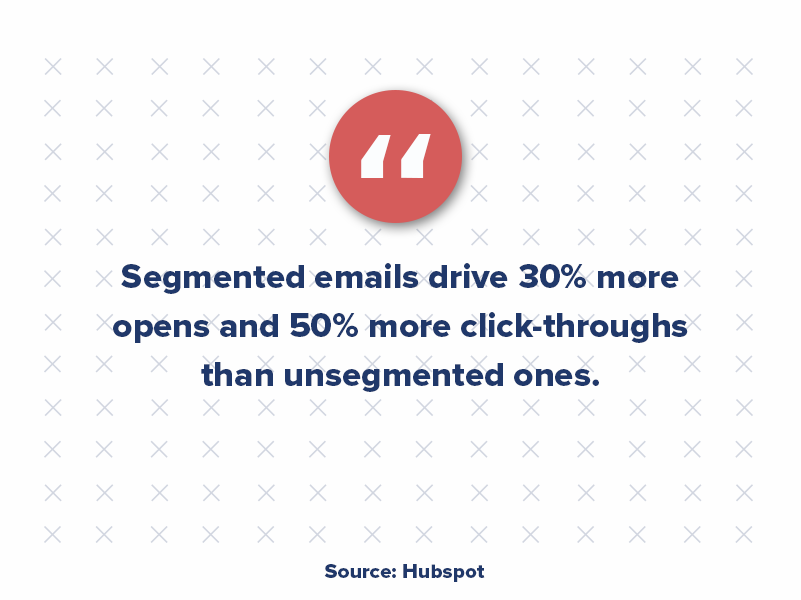
3. Enhanced Engagement
Through automated emails, multifamily companies can maintain regular engagement with their audience. These automated touchpoints inform your audience about updates, developments, and exciting opportunities. This consistent and proactive communication keeps your audience engaged and builds trust.
4. Time and Cost Savings
The power of automation lies in its ability to handle repetitive tasks efficiently. With email automation, multifamily companies can automate tasks like sending welcome emails, distributing resources, and nurturing leads. This automation not only saves valuable time but also reduces operational costs. With automated processes, companies can redirect their resources toward building and strengthening customer and client relationships.
Incorporating email automation into their strategies, multifamily companies unlock a range of benefits that enhance engagement and satisfaction and lead to substantial time and cost savings. It’s a dynamic tool that empowers these companies to operate more efficiently and effectively.
5. Monitoring Analytics in Real-Time
Marketing automation platforms provide real-time analytics to track the performance of your email campaigns. You can monitor open rates, click-through rates, conversion rates, and more. These insights empower you to make data-driven decisions and refine your strategies.
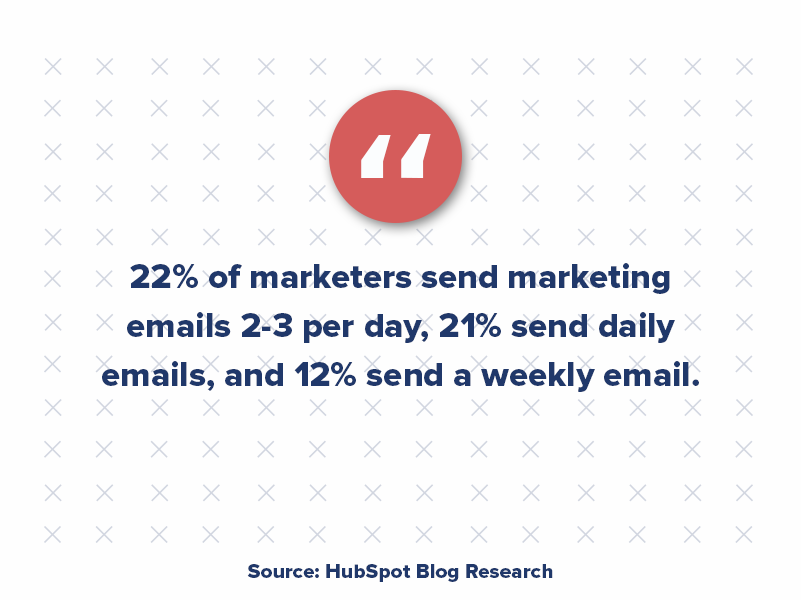
6. Never Losing Track of a Lead
Managing leads from various sources in the multifamily industry can be daunting. Marketing automation workflows automate lead nurturing. Set up drip campaigns that deliver timely and relevant content to leads, keeping them engaged and moving them through the sales funnel.
Creating a Content Marketing Workflow
Consistency is the cornerstone of effective email marketing. To ensure your emails consistently provide value to your audience, you need a well-defined content marketing workflow.
Here’s a step-by-step guide to help you create a content marketing workflow that guarantees your multifamily emails are always valuable and engaging:
Step 1: Define Your Objectives
Begin by setting clear objectives for your email marketing campaign. What are you trying to achieve with your emails? Are you aiming to educate your audience, promote new properties, or provide valuable insights into the multifamily market? Defining your objectives will guide your content creation process.
Step 2: Know Your Audience
Understanding your audience is paramount. Segment your email list based on demographics, preferences, and interests. This segmentation allows you to tailor your content to specific groups, ensuring each email resonates with its intended recipients.
Step 3: Content Ideation
Brainstorm content ideas that align with your objectives and audience segments. Consider creating a content calendar to plan your email topics and publication dates. Your content should address your multifamily investors’ and partners’ pain points and interests.
Step 4: Content Creation
Once you have your content ideas, it’s time to create them. Whether it’s informative articles, property updates, market trends, or investment opportunities, ensure your content is well-researched, engaging, and valuable. Invest in high-quality visuals and copywriting to enhance the overall quality of your emails.
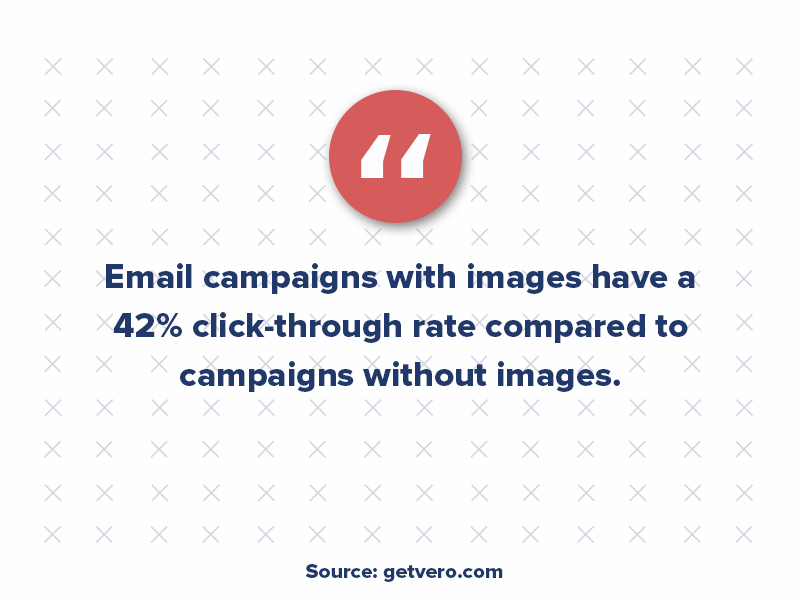
Step 5: Email Templates
Design visually appealing email templates that are mobile-responsive and user-friendly. Your templates should align with your brand’s identity and make it easy to present your content effectively. Many email marketing platforms offer customizable templates for this purpose.
Step 6: Scheduling and Automation
Set up an email schedule that aligns with your content calendar. Automation tools within your email marketing platform can help you schedule emails in advance, ensuring timely delivery to your audience. Automation also allows you to segment emails based on user actions and preferences.

Step 7: Personalization
Implement personalization tactics within your emails. Use recipient names, dynamic content, and personalized recommendations based on their past interactions with your emails. Personalization adds a human touch and increases engagement.
Step 8: Testing and Optimization
Regularly test different elements of your emails, such as subject lines, content layout, and visuals. Analyze open, click-through, and conversion rates to identify what works best for your audience. Use these insights to optimize your content and email strategies continuously.
Step 9: Reporting and Analysis
Leverage the analytics provided by your email marketing platform to track the performance of your emails. Monitor key metrics like engagement, unsubscribe rates, and conversion rates. Use this data to refine your content marketing workflow and make informed decisions.
Step 10: Feedback Loop
Encourage feedback from your audience. Provide opportunities for subscribers to share their thoughts and preferences. Use their input to fine-tune your content and ensure it consistently meets their expectations.
Which Email Automation Platform Is Best?
While numerous email marketing platforms exist, Go High Level and Hubspot are two of our favorites. This platform offers an all-in-one solution for multifamily businesses, encompassing a wide range of marketing automation tools within a single platform. This comprehensive approach simplifies your email marketing endeavors by consolidating campaign management, CRM integration, and lead tracking under one roof.
Automation is at the core of Go High Level’s capabilities. You can automate lead nurturing, follow-up sequences, and even appointment scheduling. The platform also seamlessly integrates with other tools and platforms, including CRM systems and lead generation tools, allowing you to build a cohesive marketing ecosystem.
Automation is the key to unlocking the full potential of your multifamily email marketing strategy. It’s the tool that can help you streamline your efforts, improve lead management, and deliver measurable results. By embracing marketing automation workflows and leveraging tools like Go High Level, you can elevate your email marketing services and stay ahead in the multifamily industry.
The True Value of a Qualified Lead in Multifamily Marketing
For commercial real estate marketing professionals, adapting to the rapid shift toward digital methods is both challenging and essential. Traditional property marketing techniques, honed over decades, are familiar to many. Yet, the evolution of the commercial real estate market trends points unmistakably toward the burgeoning significance of online platforms and digital outreach.
Navigating this digital realm can often feel like venturing into uncharted territory. While old marketing methods are quickly embraced due to years of experience, commercial real estate digital marketing strategies often face skepticism. These modern strategies’ tangible benefits and efficiencies, such as lower implementation costs, are frequently overshadowed by doubts and resistance. This evolving scenario poses a unique problem for multifamily marketing managers attempting to position themselves at the forefront of real estate marketing strategy innovation.
So, how can one effectively convey the value of a lead, especially a qualified apartment lead, within this digital framework? The challenge might seem daunting, but understanding and leveraging the potential of digital tools is crucial for marketers determined to stay ahead in the game.
The Quantitative: Doing the Math
When navigating the intricacies of multifamily marketing, one of the foremost concerns that real estate agents and marketers face is justifying the costs to their executive team. While these teams frequently zoom in on ROI as the primary measure of success, a holistic view of marketing efforts suggests this isn’t the only metric that matters.
Why? Understanding the ROI in the world of real estate marketing requires a deep dive into the needs and behaviors of the target audience. Further complicating matters, there are numerous ways to calculate marketing ROI, each offering unique insights tailored to different real estate marketing ideas.
For those deeply entrenched in commercial real estate marketing, the prevalent method to gauge ROI is the “cost per lead.” But here’s where many face a problem: Does this metric encompass all leads, or does it specifically address qualified leads? If you’re using a real estate website to generate leads, search engines can often bring a mix of visitors, not all of whom are part of your target market. When examining the broad spectrum of all leads, the cost-per-unqualified lead will invariably seem more economical.
However, a closer look reveals the nuances. Many of these leads, especially those seeking properties like office space or virtual tours of property listings, might not align with what’s being offered, making them a less-than-ideal fit or not ready to purchase.
This initial cost, often deceivingly attractive, fails to factor in the lead’s position in the buyer’s journey, whether they’re just becoming aware or on the brink of making a decision. Consequently, this metric overlooks essential expenses, such as the costs of nurturing these leads through tailored marketing strategies or the eventual sales pitch.
Cost Per Lead
However, the standard “cost-per-lead” is likely a sufficient metric for companies playing the lead generation game. That formula is simple enough. You take the marketing spend and then divide it by the number of leads.
Marketing Spend / Total New Leads = Cost Per Lead (CPL)
But depending on your end goals, this may not be the number your executive team wants. They may be more interested in your cost per marketing qualified lead (MQL) — or a lead ready to go to sales. This number is not too complicated, either.
Divide the marketing tactic spend by the number of MQLs you got through that method. That’s your MQL cost. Not tracking MQLs? You will not be able to backtrack your MQLs, but we have some tips on setting up your lead qualification for the future.
Marketing Tactic Spend / Total New MQLs = Cost Per MQL
This metric will likely garner better interest than a standard cost per lead, but executives will likely want more. This is where “return on spend” comes in, which shows the actual value of your efforts by relaying how those efforts impacted your bottom line. In other words, it’s the amount you earn in the business compared to your spend. This number is much harder to get; however, it can be a significant selling point in convincing your boss of the value of your efforts.
First, you must know the lifetime value of your customers.
Lifetime Value
Calculating the lifetime value of your customer is simple enough, but your formula will vary based on the nature of your product or service. If you are a subscription-based service, you will want to know the average monthly spend of a customer. If you offer a one-time product or service, you must consider typical upsells, which can increase your averages. There’s no simple formula, but once you go through this process with your sales data, you should be able to come up with a reasonable average.
The next step is to look at conversion rates of qualified leads — namely, how many marketing-qualified leads become sales-qualified leads and the average close rate of a sales-qualified lead. Got that number? You are going to use it to calculate the MQL value.
MQL Value
The MQL value is vital because it benchmarks how much an MQL should be worth. It’s also key in calculating return on spend. With this number and your cost per MQL, you can calculate the return on any marketing spend — email campaign, social media ad, etc. It’s as simple as dividing the MQL value by the cost per MQL
MQL Value / Cost Per MQL = Return on Spend
This number can help commercial real estate marketers justify marketing endeavors. However, it’s not the only one you should look at. A better snapshot number could be “return on campaign,” which looks at your endeavors. Much like a standard ROI number, return on campaign operates on similar calculations, but while looking at the components of your marketing campaign over the set time it ran.
Traditional ROI computations look like this:
(Sales Growth – Marketing Cost) / Marketing Cost = Return on Investment
However, with campaigns in mind, there are often different or additional costs involved, and not all sales may result from the campaign. If you run a single campaign at a time, you could modify this calculation to reflect any natural growth you see on average.
(Sales Growth – Marketing Cost) / Marketing Cost – Avg. Organic Growth = Return on Campaign
This gives you a more standard return that executives are used to interacting with. However, if you run multiple campaigns simultaneously, you can calculate individual returns on each campaign by taking a more roundabout approach. This involves looking at customers acquired from the campaign and multiplying the average sales and margin. Then, you subtract your campaign budget. This gives a more accurate number as to the contributory effect of each campaign.
(# Campaign Customers * Avg. Sale Amt. * Avg. Margin) – Campaign Budget = Return on Campaign
These numbers may not be simple to master or even remember; however, they’re a great way of proving marketing’s worth to your executive team.
The Qualitative: Remembering the Immeasurable
People like numbers because they are easily digestible. A number tells a simple story. But a number can also be manipulated. And a number doesn’t always tell the full story. Often, having numbers is not enough — you also need a narrative. This is where “qualitative” value comes in.
A great return on spend will undoubtedly do well to impress your C-suite with your marketing efforts. But what if you told them you also could decrease your sales cycle by a few months? That would garner strong attention as well. This is just one example of qualitative value when discussing your marketing endeavors — and the unexpected benefits of running a solid digital marketing campaign.
Digital Marketing Is Iterative
Another positive qualitative value? Certain parts of a digital marketing strategy are iterative. Commercial real estate marketers may need to develop new content or web pages for campaigns, but much of the groundwork is already done. And most of it will not need to be done again. Or at least not soon.
Buyer personas and the associated buyer’s journey may need adjustments over time. However, none of that will compare to the initial costs of developing these items. This means that over time, your ROI will likely decrease, as the costs of these components can technically be spread across each campaign. It’s hard to calculate this as a number, but it certainly goes into ascribing value to the lead process.
Qualified Leads for Commercial Real Estate Marketers
The biggest qualitative value that inbound offers is qualified leads. Traditional marketing methods gather unqualified leads sent to sales — or worse, cold-calling. On the other hand, inbound marketing puts a process in place that qualifies leads naturally through offers and nurture campaigns.
This systematically improves the marketing process, allowing leads to qualify themselves as you push out more content. In turn, you shorten the time and resources the sales team spends qualifying leads. This means commercial real estate marketers’ qualified leads from the inbound process cost less than the qualified leads you get through another method.
The Bottom Line of Lead Value
So, what does this mean for commercial real estate marketers?
Pulling it all together, a digital marketing program like multifamily inbound marketing allows you to ascribe worth to the apartment leads you gather easily. Multifamily inbound marketing also enables you to prove that the costs and returns associated with those leads are of greater value to your business than leads garnered from more traditional methods.
In coupling calculations like return on spend, you can prove your leads’ quantitative and qualitative value. As we noted previously, inbound marketing offers improved cost-per-lead values and lower implementation costs. But it’s one thing to know it and another thing to prove it to your executive team.
Navigating the Balancing Act Between Sales and Marketing Teams
A synergy between sales and marketing teams lies at the heart of a successful multifamily marketing plan. In the commercial real estate sector, marketing centers on intelligence and data gathering, while sales focus on execution; yet, their roles are deeply intertwined.
The marketing team dives deep into rent data, conducts market research, and absorbs the multifamily industry’s broad scope. Based on this data, they identify potential leads and then pass the baton to sales. The sales team then educates the public, forges relationships, and drives new business acquisitions while gathering invaluable on-the-ground insights.
But here’s the crux: even though their day-to-day functions differ, one cannot thrive without the other.
Balancing the Equation in Multifamily Marketing and Sales
While sales and marketing may occasionally be at odds, with different perspectives and expectations from each other, their success hinges on mutual reliance.
Marketing teams need sales insights. Sales teams often offer a ground-zero perspective, giving marketing a clear picture of potential customers’ reactions and feedback. Conversely, sales teams heavily depend on marketing for aggregated data, market trends, and overviews, ensuring they align with the broader business strategy.
But how do you ensure this balance is maintained?
Bridging the Divide for Effective Multifamily Marketing Plans
To maximize the potential of a multifamily marketing plan, unity between sales and marketing is non-negotiable. Both teams should have an appreciation for each other’s roles and challenges.
Imagine if professionals had to spend some time in the opposite camp before rising to senior roles like Sales VP or Marketing VP. Such cross-functional experiences can foster mutual respect, better understanding, and more collaborative strategies.
Promote a culture where the company views sales and marketing teams as equal pillars supporting its growth. Both should operate at the same hierarchical level, emphasizing collaboration over competition. The old “us vs. them” mentality? It’s time for that to go.
Boosting Customer Engagement Through Cohesion
What is the tangible outcome of a harmonized sales and marketing approach in multifamily operations? High-quality leads. Lead quality significantly uplifts when both teams are in sync, especially in an inbound marketing framework.
Inbound marketing, peppered with rich content like whitepapers, blogs, and social media, serves as a tool to educate potential clients. With this approach, prospects are well-informed before the sales team engages them. They know the services offered, have weighed their options, and when they reach out, they ask intelligent, informed questions, streamlining the conversion process.
Remember, an effective inbound multifamily marketing plan thrives on a united front between sales and marketing.
Sales and marketing are not just departments but the twin engines propelling a multifamily business forward. Multifamily marketing plans can soar to new heights by fostering a symbiotic relationship, driving leads, conversions, and business growth. The question isn’t whether they should coexist but how best to ensure they flourish together.
How to Support Consistent Growth for Your Multifamily Business
The multifamily market has seen a paradigm shift with the rise of inbound marketing. A comprehensive perspective is vital as you construct your marketing funnel, from crafting insightful blog posts to launching targeted Facebook ads.
New marketers eager to build captivating campaigns and hone their content marketing efforts might sometimes overlook crucial elements like the leasing agent’s strategic role and the nuances of the target audience.
Without a dynamic strategy for enticing potential customers, even the most detailed funnel risks stagnation. Ensuring that every facet of your marketing efforts works harmoniously is essential for generating loyal customers.
Focusing on the Funnel
A successful marketing idea hinges on mastering the inbound marketing funnel. For those who are new to this approach, it’s common to launch numerous campaigns with a keen focus on the buyer’s journey at every stage.
However, the true secret lies in optimizing strategies for prospective customers. Emphasizing search engine optimization (SEO) ensures your business consistently appears atop search results, making it more visible to potential customers.
Campaigns certainly have their place, but the key to long-term success is concentrating efforts at the funnel’s top. This is where initial interest from potential customers is captured.
Without this interest, there’s no pool of leads to nurture or engage with. Excellent customer service and content tailored specifically for your target audience is essential. With this approach, you can guarantee a steady flow of visitors and create opportunities to convert them into long-term customers or clients.
Making Your Multifamily Marketing Funnel Scalable
The key to any business growth is scalability. But how do you translate a marketing funnel to meet scalability needs?
The first requirement is to look solely at the numbers. If you are struggling to bring in 1,500 web visitors per month and are only converting that traffic to leads at a rate of 3%, the outlook for company growth is not promising.
When faced with this kind of issue, it is essential to change your funnel, albeit one at a time. Again, your concern should be primarily on your traffic generation or how to increase that visitation from 1,500. If nothing else, an increase in site traffic to around 5,000 monthly with a steady lead rate of 3% can still significantly impact your top-of-funnel multifamily leads from 45 to 150 a month.
But how do you increase this traffic to such a rate? Again, your focus should be content. Experimenting with your content tilt, improving your content amount, and changing how you promote your content can contribute to higher traffic.
Maintain Consistent Conversion Rates
Achieving a scalable marketing funnel hinges on the stability of conversion rates, a crucial metric for multifamily marketing professionals. The effectiveness of your efforts, particularly in areas like landing pages, forms, and special offers, plays a significant role in driving these conversion rates.
For instance, if you’ve historically experienced a 5% conversion rate from visitors to leads and a subsequent 1% from leads to actual customers, it’s paramount that these figures remain steady or, even better, show improvement to ensure the potential for long-term growth.
Consistent conversion rates don’t just offer a static picture; they enable forward-thinking marketers to predict the number of potential customers or clients that may enter the lead generation pool within a given timeframe. Moreover, closely monitoring these rates allows you to gauge the number of leads likely to transition further down the sales funnel.
The integration of well-maintained buyer’s journey content, coupled with feedback from your sales team and tactics such as multifamily SEO, ensures that your content resonates with the target audience and that you are on track to meeting the overarching objectives of your marketing campaign.
Keeping Up With the Content
For businesses seeing inbound success, it is tempting to lapse in your efforts or change direction due to comfortable growth. However, this can be incredibly damaging to your business. Your content needs to be consistent.
Again, we return to the issue of scalability. Knowing that content is the basis of bringing in multifamily traffic, it’s important to maintain that generation to maintain results. But how do you do that without your content growing stale? It’s a matter of knowing your audience so that you can take a leading approach in content creation.
Ideally, as you grow, it should be simple for your business to put processes in place to become a content machine. Keeping up with your content ensures your business can continue to grow easily.
Leveraging Technology for Insightful Thought Leadership
Multifamily businesses can’t afford to lag. Integrating technology and data analytics into your marketing approach can offer significant advantages.
1. Harnessing CRM Systems
Customer Relationship Management (CRM) tools are no longer a luxury but a necessity. These platforms give you a holistic view of each prospective customer, tracing their journey from mere visitors to committed customers or clients. Analyzing this data lets you pinpoint where potential customers or clients might drop off, allowing for timely interventions and targeted strategies.
2. Data-Driven Decision Making
Relying on gut feelings is a strategy of the past. Today, successful multifamily marketers bank on actionable insights derived from data analytics. By studying patterns, behaviors, and preferences of potential customers, marketing strategies can be fine-tuned to match the exact needs and desires of the target audience. This ensures higher conversion rates and, ultimately, more signed leases.
3. Automated Marketing Campaigns
Automation in marketing can be a game-changer. Imagine tailoring specific email campaigns for different segments of your audience, triggered by particular actions they take. This ensures that the content is relevant to the recipient and reaches them opportunely, increasing the chances of conversion.
4. Continuous Learning and Adaptation
The digital landscape is ever-evolving. What works today might not be as effective tomorrow. Therefore, continuous learning and staying updated with the latest marketing trends, technological tools, and best practices are crucial. Regular training sessions, workshops, and webinars can help multifamily marketers stay ahead of the curve.
While content marketing fundamentals remain rooted in understanding and catering to the buyer’s journey, the tools and technologies available to us have greatly expanded. These tools can help you maintain traffic and ensure sustained growth and expansion in an increasingly competitive market.
The Rise and Importance of Video Marketing in Your Multifamily Marketing
Reflect on the most engaging content you’ve encountered on social media lately. Which pieces left a lasting impression, prompting you to share or tag a friend?
The undeniable force behind these memorable moments is video content. Whether it’s an amusing pet mishap, an informative tutorial, or an innovative DIY project, videos have an unrivaled power to captivate.
U.S. adults, on average, dedicate six hours daily to watching videos, and this watch time has skyrocketed by over 270% in the past year. Research indicates that more than half (54%) of consumers want to view more video content from their favored brands or businesses. Remarkably, 86% of companies now leverage video for marketing, a significant jump from 63% a few years ago.
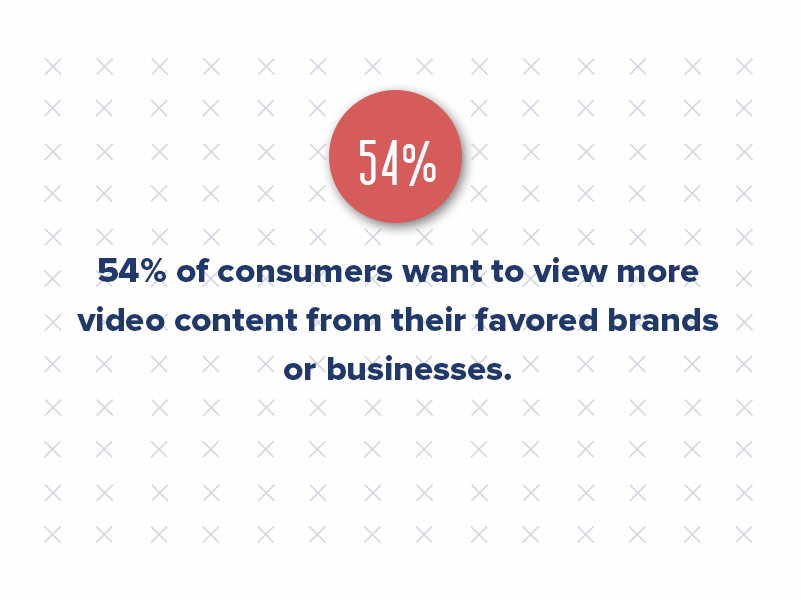
These striking statistics underscore the substantial potential of video content marketing, especially in the multifamily marketing landscape. Now is the perfect moment if you haven’t yet integrated a robust video marketing strategy.
Why Is Video Content Marketing Important?
Search engines love fresh and engaging content, and nothing fits the bill quite like creating videos. In today’s digital age, landing pages, blog posts, and other online spaces are instantly elevated when you include video. The type of video matters, too. For instance, an “explainer video” can help break down complex concepts, while a product video shines a spotlight on the unique features of your products and services.
With many video and social media platforms available, there’s never been a better time to experiment with video ads, live videos, and other video formats.

In our fast-paced digital world, consumers search for content that offers instant gratification. Videos perfectly meet this demand, enabling brands to encapsulate their core message in a short yet impactful format. When you add video to your marketing mix, it’s not just about visuals; it’s about building genuine relationships with your audience.
The art of promoting your video has also become more accessible and budget-friendly, thanks to evolving technology. Now, multifamily marketers can benefit from precise targeting on video platforms and receive in-depth analytics, making it an indispensable marketing tool. Plus, with the option to share videos widely, you increase the chances for potential customers to watch your video and connect with your brand.
Effective Content for Your Video Marketing Strategy
Understanding and integrating the importance of video within your multifamily marketing framework is crucial, but it’s just the beginning. Determining which video formats and styles align best with your business objectives can be challenging.
To navigate this landscape, here are some video marketing tips to optimize your strategy for the multifamily sector:
1. Live Streaming and Reels
Social videos are short, conversational clips explicitly designed for social media. From live streaming on Facebook to Instagram Stories, brands can cast a wide net around prospective customers and reel them in with captivating content. Given the transient attention span on social media, these videos should ideally be condensed, gripping, and under two minutes.
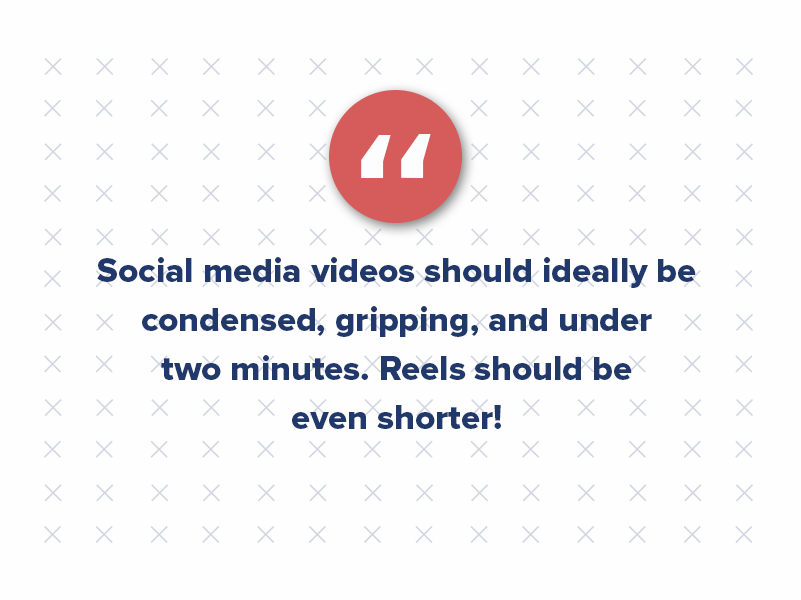
Embrace live videos, as these can be utilized for property tours, resident events, or Q&A sessions. Live interactions build authenticity and foster a deeper connection with potential residents.
2. Brand vs. Product
Brand videos offer a high-level overview of your company’s brand, mission, and style. This content can be clips of your office and showcase company culture, but it should not sell a product. You should consider a brand video as your mission statement.
Product videos, conversely, educate your audience about the benefits of your product or service. With this content, it is essential to highlight and explain customer benefits and not just the features.
Ensure you’ve added video components, landing pages, and promotional materials to your website. This enriches the user experience and positions your brand as current and responsive to digital trends.
3. Testimonials and Customer Spotlights
Customer spotlight or testimonials showcase one of your customers and how they benefited from your product or service. These videos offer a great alternative to your website’s traditional written testimonial.
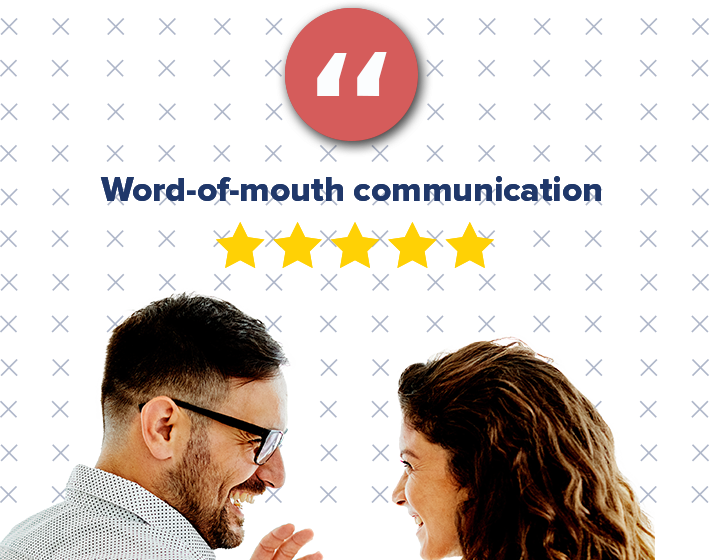
At Criterion.B, we have seen word-of-mouth communication as a powerful force — especially when building brand trust. Trust is built organically by spotlighting real customers and narrating their positive experiences, making this a vital aspect of multifamily marketing. Your prospective customers will trust the opinions of your current customers more than they trust your website content, blog, or advertisements. Video testimonials are an authentic way to capture your customer’s feedback and potentially drive more multifamily leads to your business.
4. Trending Videos
As with all marketing endeavors, staying abreast of the latest video trends and innovations is crucial. Whether it’s new editing techniques, emerging platforms, or innovative content ideas, being in the know ensures your strategy remains competitive.
Trending videos leverage a trending or timely topic at the core, whether it’s a clip related to a holiday, an upcoming election, or just a hot topic within your industry.
For example, we developed a video on the importance of building buyer personas, featured during a panel discussion at NAA Apartmentalize. The clip was timely (for the event), trending (within the multifamily market), and relevant to all of our buyer personas. Watch the full video below!
5. Interactive Content
Interactive videos offer viewers a unique, participatory experience. You turn passive viewers into active participants by embedding quizzes, polls, or clickable links. This heightened engagement ensures better retention and provides invaluable feedback. In multifamily marketing, interactive content can virtually tour potential properties, allowing viewers to choose which areas of a residence they’d like to see or even select finishes and furnishings in real time.
6. SEO Video Marketing
Your video’s content is only as effective as its discoverability. SEO video marketing is vital. Ensure your video titles, descriptions, and tags are optimized with relevant keywords. Moreover, to make your content inclusive, provide subtitles or closed captions. This not only aids viewers with hearing impairments but also caters to those who watch videos without sound, which is a significant portion of viewers, especially on social media platforms.
Integrating these video marketing tips can further elevate your multifamily strategy, ensuring you reach a broader audience while providing engaging and valuable content. Remember, in today’s digital age, it’s not just about producing videos — it’s about creating videos that resonate, inform, and inspire.
5 Ways Video Content Can Drive Multifamily Website Traffic
With “doom scrolling” rising, capturing and maintaining a visitor’s attention on your website can be a significant challenge. However, integrating videos into your web content offers an effective solution. Here’s how:
1. Enhance Your User Engagement
Embedding videos in your blog posts or web pages can dramatically increase user engagement. Instead of skimming through a lengthy article, viewers can watch a video that summarizes or complements the content. This multimedia approach appeals to a broader range of learning styles — while some might prefer reading, others gravitate toward visual or auditory content.
2. Increase the Average Time on Page
One of the crucial metrics search engines use to gauge the quality and relevance of a page is the amount of time a user spends on it. A compelling video can keep visitors on your page for extended periods, signaling to search engines that your content is valuable. This can subsequently improve your site’s search engine ranking, making it easier for potential customers or readers to discover your content.
3. Reduce Bounce Rates
A “bounce” occurs when a visitor lands on a page on your website and leaves without interacting with any other part of your site. A high bounce rate can negatively impact your SEO ranking. Videos, with their innate ability to captivate, can mitigate this. By embedding a video, you’re giving visitors an additional reason to stay and explore, reducing the likelihood of a bounce.
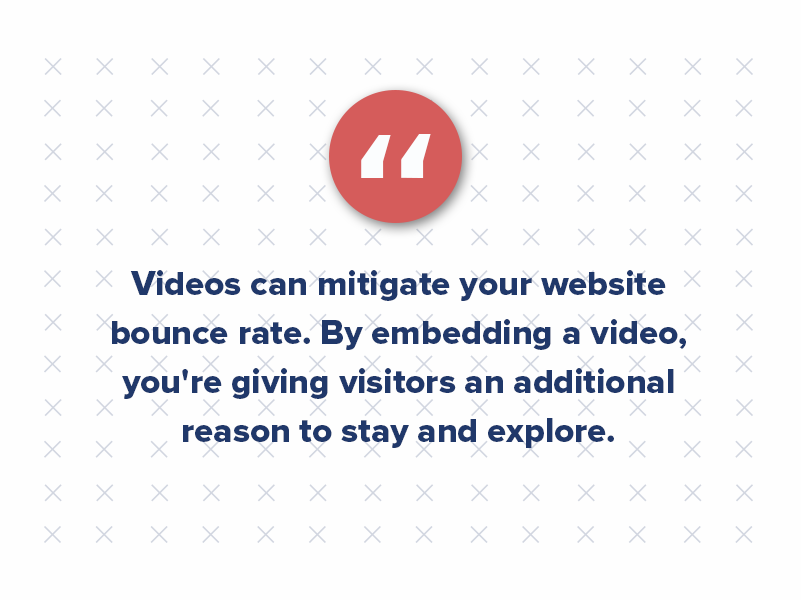
4. Boost the Shareability of Your Site
Video content is inherently shareable. Visitors who find your video insightful, entertaining, or valuable are likelier to share it on social media platforms or with their network. Every share increases the potential for more traffic to your website, creating a virtuous cycle of engagement and discovery.
5. Improve Your Content Diversity
A diverse content strategy appeals to a wider audience. By embedding videos in your blog posts, you’re catering to those who prefer watching over reading. This diversity can make your website a go-to resource for information, ensuring repeat visits and consistent traffic.
Captivate Your Customers With SEO Video Marketing
While social media videography plays a crucial role, broadening your scope to include video across your website, landing pages, and emails is vital. Don’t limit yourself to just one type of video. From explainer videos detailing your amenities to animated infographics showcasing resident testimonials, diversifying your video formats can cater to varied audience preferences and increase engagement.
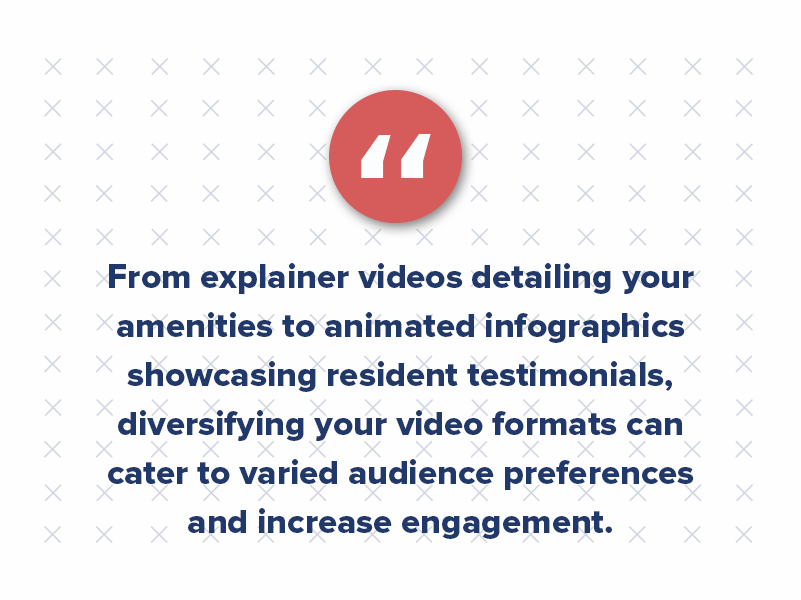
Delving into the benefits of video marketing reveals that it doesn’t just enhance engagement; it boosts SEO rankings, fosters trust, and increases conversion rates. Video marketing tips can help businesses optimize their content for SEO video marketing, ensuring their videos rank higher and reach a broader audience.
While the concept of branded video content’s immense multifamily marketing potential isn’t novel, its soaring popularity among consumers and its heightened significance to marketers certainly is. To stay competitive and resonate with your audience, harnessing this trend is no longer optional but imperative.

Why Inbound Marketing Trumps Outbound in Property Management
Who does not love referrals? But we live in a new digital world where people do not need to pester their neighbors to find a good recommendation — they have a slew of information at their fingertips via smartphones.
Think about what your top source of new business leads was last year for your property management company. If your answer was “word of mouth,” you are probably in trouble. If you answered “I don’t know,” you are arguably in even more trouble.

The real estate and property management sectors have significantly transformed over the last few years. Traditional marketing methods that once dominated the scene gradually changed modern tactics.
One notable shift has been from outbound to inbound strategies, particularly in the property management marketing realm. But what is causing this shift, and why is inbound marketing proving to be more effective?
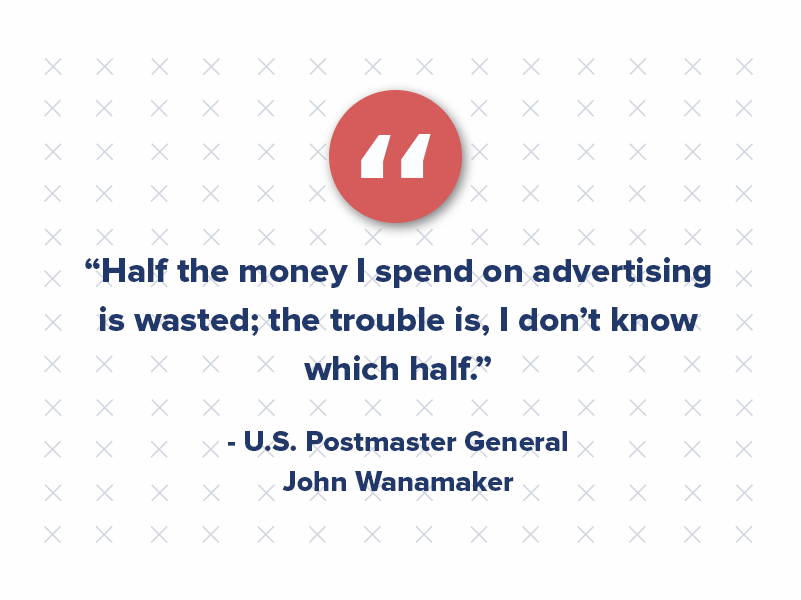
Whoever is working on your property management marketing strategy — whether it is an agency or an in-house multifamily marketing team — should be able to track your investments back to actual multifamily leads and revenue for your business.
Understanding the Outbound vs. Inbound Divide
Before diving into the specifics, it’s important to understand the core differences between outbound and inbound marketing.
There are a lot of definitions floating around about what inbound marketing is, but an easy way to think about it is to think of the leads flowing in versus you scouting them. A good example of inbound marketing is search engine optimization (SEO). A property management company with a website ranking highly in the search engine results for relevant keywords will likely have a good flow of multifamily leads.
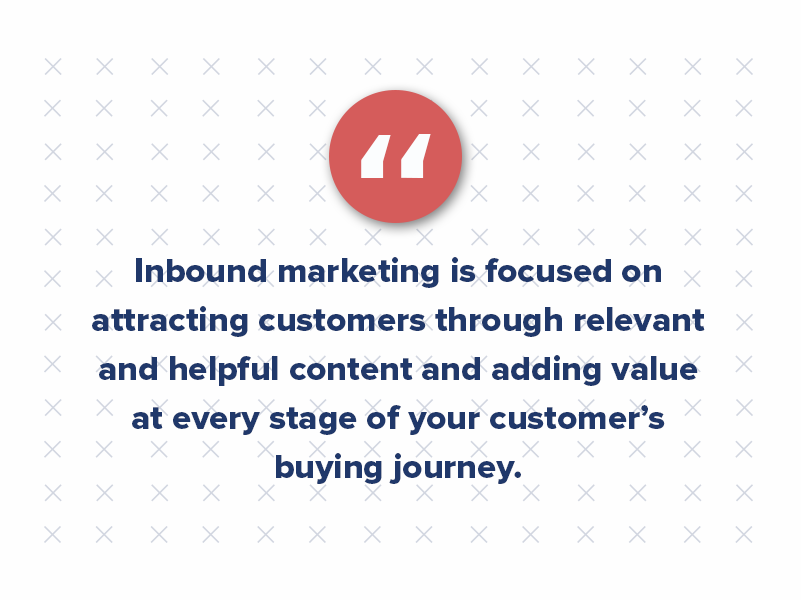
Outbound Marketing: This is the “old school” method of reaching potential customers. It involves pushing a message out, often to a large audience, hoping for a response. Examples include TV commercials, radio ads, print advertisements, and cold calls.
Inbound Marketing: This is a more contemporary approach where businesses create valuable content and experiences tailored to potential clients. It’s about attracting clients to come to you. This method revolves around content creation, search engine optimization, and social media marketing.
1. It’s more cost-effective than traditional outbound marketing.
Budget considerations are paramount for any property management marketing plan to succeed. In many instances, inbound marketing has proven more cost-effective than its outbound counterpart. Creating quality content might require an initial investment, but its long-term organic reach often surpasses that of costly traditional ads.
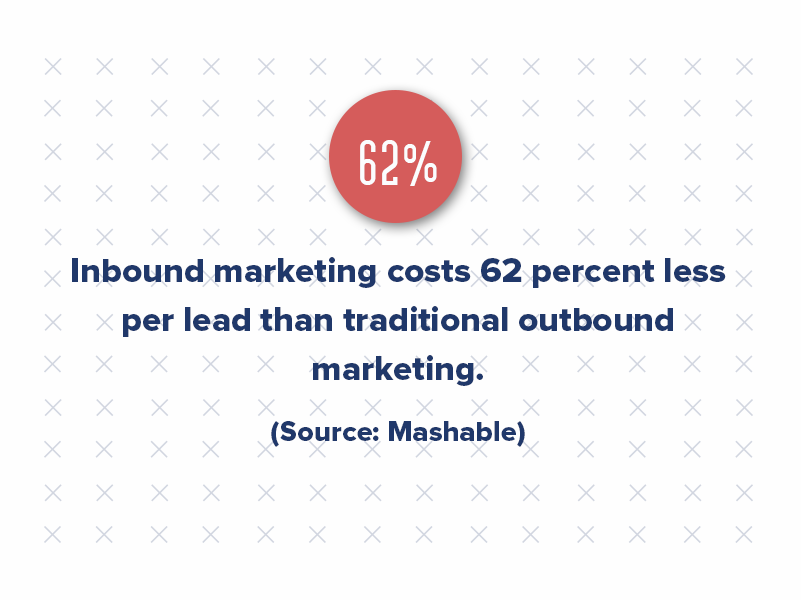
2. It helps build trust and brand loyalty with your target audience.
One of the most compelling reasons inbound marketing is taking the lead in marketing for property management is the trust factor. Inbound marketing relies heavily on content creation, which can position a property management company as an industry expert. Over time, this builds trust and credibility with the audience, something outbound methods might struggle to achieve.
3. It provides better audience targeting and precision.
With inbound marketing, you’re drawing in those already interested in property management or actively seeking your services. Advanced tools and analytics allow businesses to tailor their property management marketing plan to target specific demographics. This level of precision ensures a higher conversion rate.
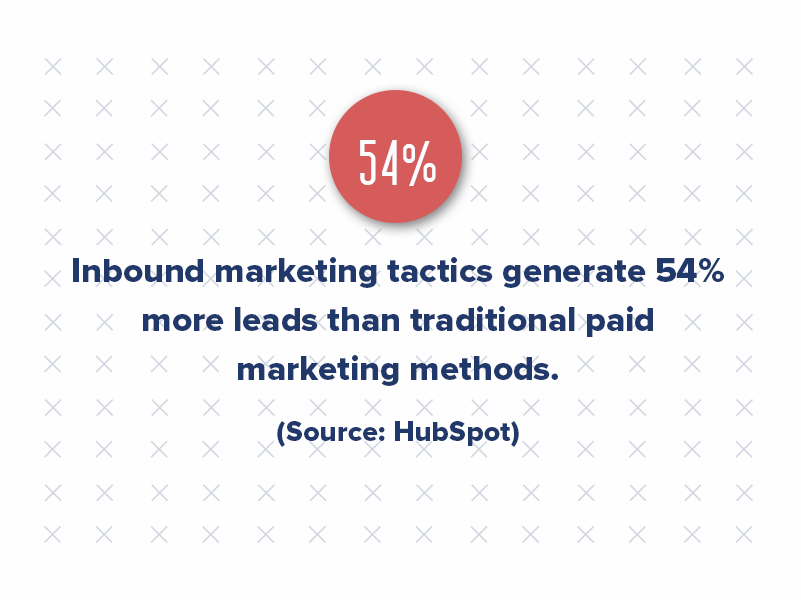
4. It allows for quick adaptations to algorithm changes.
A branding and digital marketing agency can attest to the fast-paced evolution of online trends. Inbound marketing, being inherently digital, allows for quick adaptations. Whether it’s a change in search engine algorithms or the rise of a new social media platform, inbound methods can easily pivot to stay relevant.
5. It promotes engagement and positions you as a thought leader.
Modern consumers prefer engagement over mere advertisements. They’re more inclined to interact with informative blogs, insightful infographics, or engaging videos. An effective property management marketing plan will leverage this preference, creating content that informs and engages.
6. It enhances your credibility and multifamily SEO.
Search engine optimization (SEO) is a cornerstone of inbound marketing. With most consumers beginning their property management search online, ensuring your business ranks high on search engine results is crucial. Inbound marketing directly taps into organic search traffic by focusing on SEO strategies, offering higher visibility and credibility.
4 Inbound Marketing Advertising Channels to Prioritize
In the digital age, the strategies employed in marketing for property management have expanded beyond traditional methods. Today, the landscape is diverse, with multiple channels offering unique ways to capture audience interest.
From the intricate art of email campaigns to the immediacy of PPC ads, each channel brings its distinctive advantage to the table. Below, we explore four pivotal multifamily inbound marketing channels and why they are becoming indispensable components of a robust property management marketing plan.
1. Email Marketing
Are you tracking if you get any multifamily leads from those direct mailers? Printing and mailing are costly and do not necessarily target your prospective customers when they are actively seeking your services.
While it has been ingrained in society that digital marketing is the future, groups with no expertise in the industry are unsure how to use digital marketing strategically. Partner this with a hesitancy to leave behind expensive “tried and true” outbound methods like direct mailers, and it becomes clear that while the multifamily industry knows digital marketing is the future, they are not quite sure how to invest in it.
While plenty of companies still purchase email lists to send their marketing e-blasts, there is a better option. Offer your prospective customers valuable content — like a quiz, fact sheet, or infographic — in exchange for their email. Over time, you will build a robust opt-in email list that is more likely to have engaged contacts.
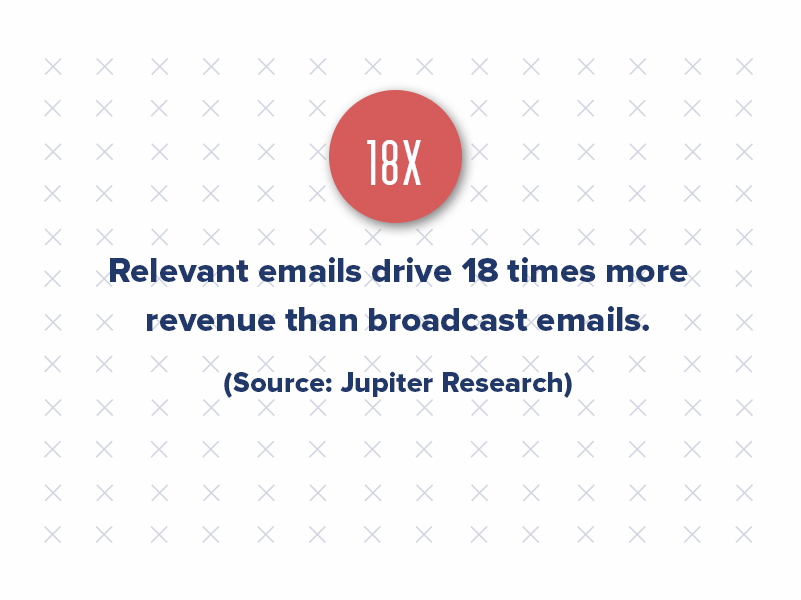
With email marketing, there’s no waiting for the postman or printing costs involved. A single click sends your message to hundreds or thousands of recipients instantaneously. However, the true magic lies not just in the speed of delivery but in how email marketing can be tailored and personalized for maximum engagement.
Let’s delve into the benefits:
- List Segmentation: One of the true strengths of email marketing is the ability to segment your list. You can categorize your audience based on demographics, previous interactions with your brand, or even their position in the buying journey. This means that instead of sending a generic message to everyone, you can tailor your communication to resonate deeply with specific segments of your audience, leading to increased conversions.
- Increased Conversions: When you offer value in exchange for an email address, you’re essentially filtering in an audience that’s already shown interest in what you have to offer. Such opt-in lists increase engagement rates because the audience is already partially invested.
- Tracking and Analytics: Unlike direct mailers, email marketing platforms offer detailed insights into your campaigns’ performance. You can see who opened your email, which links they clicked on, and even how much time they spent reading.
- Environmental Friendliness: Without needing paper, ink, or transportation, it’s a method that’s kinder to our planet.
2. Pay-Per-Click Advertising (PPC Ads)
Optimizing your multifamily website to rank on the first page of search engine results is a long-term strategy that can pay off in the future. On average, 49,500 people search the keyword “property management companies” each month. Your target demographic will likely miss you if you are not located on the first page of search results.
Organically getting your website to rank high in search engine results can take time. That is why it can be beneficial also to pay to advertise in the search results. There are a lot of paid search advertising strategies that an agency can recommend and help you implement. For instance, you can pay for your PMC to show up when someone searches for your competitors.
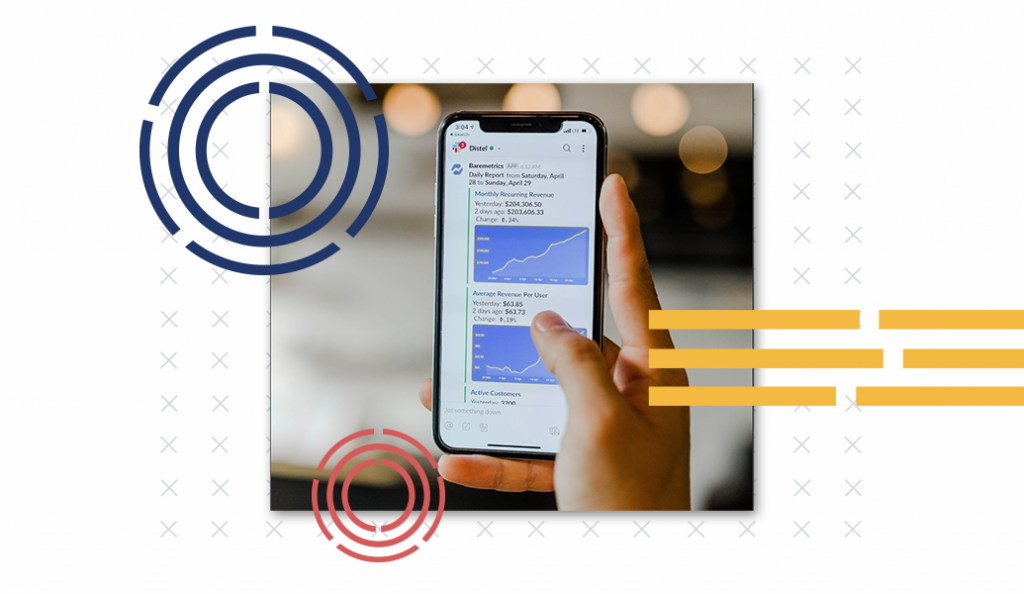
3. Display Advertising
Display advertising — particularly in a campaign where you specifically target users who left your website before contacting you — is also a worthwhile campaign to test. At its core, display advertising is about presenting visually appealing banners, images, or videos across a range of websites your target audience frequents.
One of the most effective strategies within display advertising is “retargeting” or “remarketing.” Have you ever wondered how that specific property you were eyeing suddenly popped up on various other websites you visit? That’s retargeting in action. It specifically targets users who visited your property management site but left without contacting you, making a booking, or completing another desired action. By reminding them of their previous interest, you significantly increase their chances of returning to your site and converting into a potential lead.
Here’s why investing time and resources into display advertising can fortify your property management marketing plan:
- Visual Impact: Unlike text-based ads, display ads capture attention instantaneously. With the right design and branding elements, they can make your property memorable.
- Tailored Targeting: Through sophisticated algorithms and user data, display ads can be tailored to specific demographics, ensuring that your properties are showcased to those most likely to be interested.
- Brand Awareness: Even if a user doesn’t immediately click on your ad, the consistent presence of your properties on multiple platforms reinforces brand recognition. Over time, this can lead to increased trust and a higher likelihood of them choosing your services when they’re ready.
- Measurable Results: Much like other digital strategies, display advertising offers insights into your ads’ performance. You can track metrics like impressions, clicks, and conversions, adjusting your approach accordingly for better results.
4. Social Media Advertising
Search engines are not the only place you can pay to advertise. In fact, social media sites like Facebook and LinkedIn offer even cheaper advertising options that can potentially deliver sizeable returns on ad spend. Boosting content through social media advertising can increase your reach, impressions, and engagement.
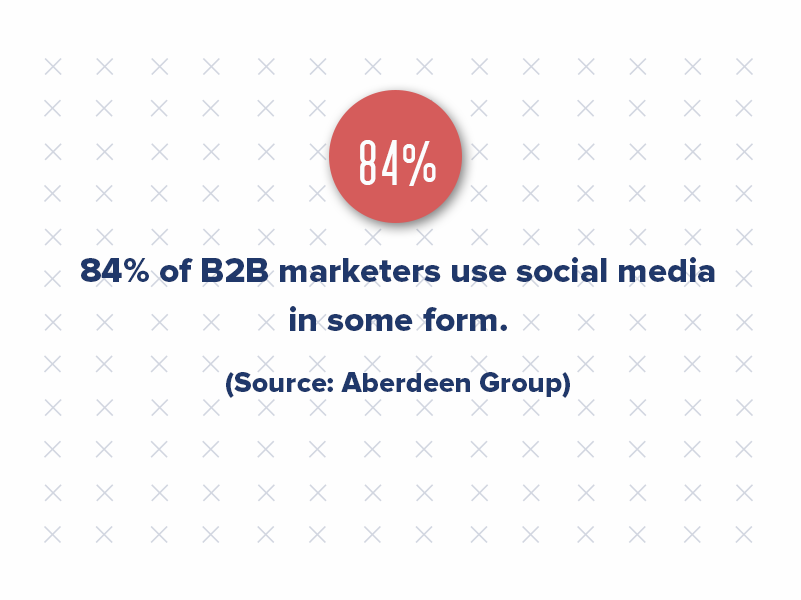
The Role of a Branding and Digital Marketing Agency
While it’s possible to devise an inbound marketing strategy in-house, partnering with a branding and digital marketing agency can elevate your efforts. Such agencies bring expertise in content creation, SEO, social media strategy, and more, ensuring your property management marketing plan is comprehensive and effective.
While outbound marketing still has its place, the future seems to tilt in favor of inbound strategies, especially in the realm of property management. The ability to effectively target potential clients, engage with them meaningfully, and adapt to digital trends makes inbound marketing for property management a winning approach. As the landscape continues to evolve, companies embracing this shift and investing in a well-structured property management marketing plan will likely stay ahead of the curve.

Maximizing Occupancy & Revenue: Strategic Insights for Multifamily Property Success
High occupancy rates are the golden ticket to success in multifamily real estate. But how do you attract and retain tenants consistently?
Today, we’re diving into some tactical tips to boost occupancy and increase your net operating income (NOI). Through the lens of property management marketing and multifamily branding, let’s unlock the potential of your property.

1. Revamp Your Online Presence
Modern tenants scout online before they visit in person. And there is nothing worse than an unresponsive, slow-loading multifamily website. A modern web design can be the difference between one lead and dozens. Ensure your website is mobile-responsive, user-friendly, and provides comprehensive information, all while encapsulating your multifamily branding essence.
Our multifamily branding agency will deliver a high-quality, responsive website and handle your apartment marketing so you can focus on what matters most — nurturing your leads.

2. Dive Into Social Media
Social media is indispensable in property management marketing. Platforms like Instagram and Facebook can showcase your property’s amenities, community events, and testimonials.
We treat your social media as an extension of your website — by embracing your customers and serving them relevant content. Our team of social media experts will help adhere to your brand voice to concept, publish, and manage daily social media content — including Stories, Reels, and lead-generating ads.
3. Hire a Multifamily Branding Agency
Are there inconsistencies in your multifamily branding? Are you ranking low in search results — or even not at all? Are you losing leads to your competitors? Has your multifamily marketing plan fallen by the wayside? Don’t let sporadic multifamily marketing and branding stunt your NOI.
An expert multifamily branding agency can help refine your brand, ensuring it aligns with your target audience and stands out from competitors. An agency can also offer invaluable insights and solutions to uplift your brand. Our seasoned perspective ensures your brand resonates with your target audience, distinguishing you from competitors. Moreover, with our comprehensive market knowledge and analytical approach, we can identify and rectify hidden challenges or overlooked gaps hindering your brand’s full potential and stunting your NOI.
4. Host Community Events
Community BBQs, game nights, or workshops can provide a sneak peek into the vibrant life prospective tenants can expect, driving occupancy. We recommend hosting small, more affordable events every month (at least) and larger events every quarter. You should also aim for one significant event open to the public each year, such as a large Battle of the Bands, a Christmas celebration, or a charity event with raffle prizes. These large events will draw in the broader community and spread the word about your property.
5. Offer Referral Incentives
Encouraging current residents to refer friends or family is a strategic move in resident acquisition. Many trust recommendations from those they know, making this a reliable method to attract potential renters. Offering your current residents a discount on their next month’s rent or a bonus, such as a gift card to a popular local restaurant, can incentivize them to promote your property actively.
6. Professional Property Photos
High-quality photos can make a vast difference in online listings. Consider hiring a professional for interiors and exteriors to put your best foot forward. A multifamily branding agency can also help you coordinate a professional photographer, so there is no sweat off your back!
7. Revise Your Marketing Materials
Update brochures, banners, and flyers. Ensure all marketing for property management showcases the latest amenities, resident testimonials, and any recent renovations. If you recently rebranded your online presence, you need this to reflect in your marketing materials.
A multifamily branding agency can help you pinpoint all the collateral pieces that need to be updated and upscale those branding elements to match the look and feel of your new brand experience. From rack cards and brochures to banners and event flyers, we can help you generate apartment leads with premium collateral.

8. Enhance Security Measures
Safety is a top priority for many renters. Implement security cameras, keyless entries, or 24/7 security personnel to boost your property’s appeal. Once these are all updated, promote them with pop-ups on your website, add them to social media, and send an e-blast newsletter to current and prospective residents on your email list. This can show current residents you are bettering the property for their benefit and show prospective renters that you prioritize a safe community.
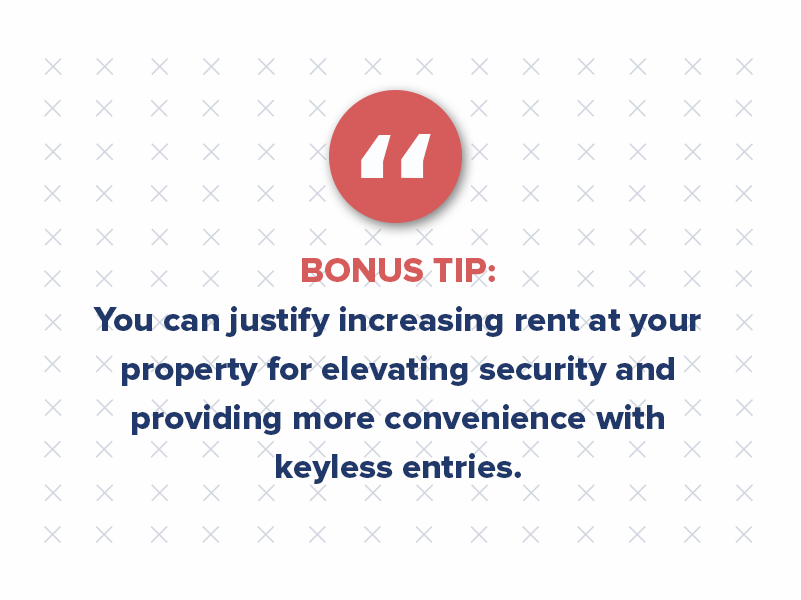
9. Offer Flexible Lease Terms
While not ideal for all properties, consider short-term leases or rent-by-room options. Flexibility can attract a wider range of potential residents. The short-term rental industry has seen an unprecedented surge in growth in recent years. In fact, the short-term rental market is expected to reach a valuation of $8,907.1 million by 2026. If your property has the means and logistics to tap into this market, you could open the door to some lucrative NOI.
10. Pet-Friendly Policies
Did you know that 72% of renters have pets, yet problems finding and keeping rental housing is a leading reason dogs and cats wind up in shelters?
Despite pets being prevalent in two-thirds of American households and integral to communities, many renters face challenges securing pet-accommodating residences. Shockingly, this housing dilemma leads to over half a million pets being surrendered to shelters annually, with many failing to find new homes. Even though the rental housing sector claims about 78% of apartment complexes are pet-friendly, the reality often contrasts starkly. Many properties impose weight restrictions, such as no dogs over 25 lbs. or having breed limitations. Hence, “pet-friendly” doesn’t truly represent most of America’s pets.
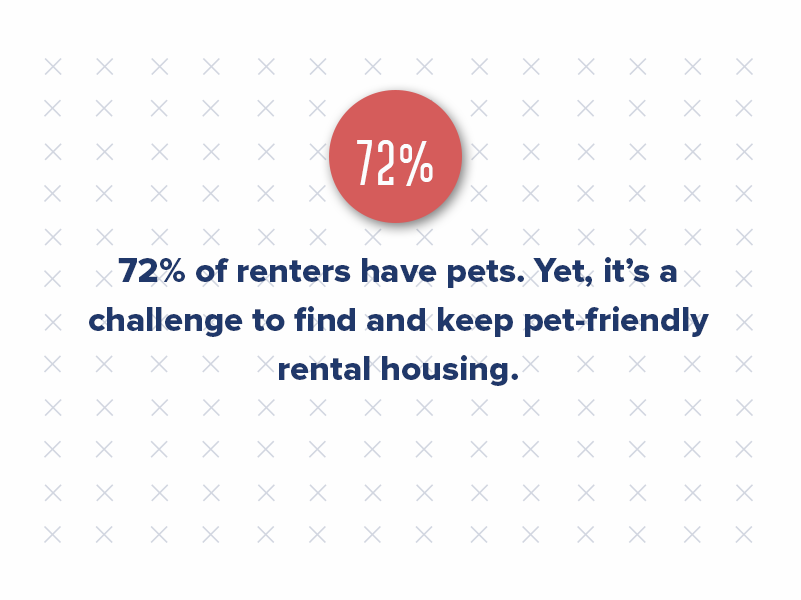
With more people adopting pets, offering a true pet-friendly policy (with appropriate rules) can be a significant attraction. Massive bonus points for the properties that also offer up pet-friendly amenities like dog washing stations, pet parlors, dog parks, and more. (p.s. This is also another way you can justify a rent increase!)
11. Implement Tech Upgrades
In today’s digital age, properties need to adapt to the ever-evolving technological demands of residents. Smart home features, such as voice-activated lighting, automated thermostats, and advanced security systems, offer convenience and modern living standards that appeal to a wide audience. High-speed internet has transitioned from a luxury to a necessity, especially for remote workers, avid gamers, or streaming enthusiasts.
Additionally, app-based service requests provide residents with a seamless way to communicate their needs directly to property management without the hassle of calls or in-person visits. As most people, regardless of age, have become adept with technology, integrating these features can significantly enhance the living experience and make a property more attractive to potential renters.

12. Maintain Immaculate Common Areas
First impressions matter. A visitor’s initial encounter with a property often sets the tone for their entire experience. Lobbies, hallways, and other shared spaces are the first touchpoints for prospective residents. Regularly cleaning and updating these areas is crucial for aesthetics and communicating the property’s commitment to maintaining a high-quality living environment. A clean and modern space exudes professionalism and care, making it a no-brainer for properties aiming to attract and retain residents who value such attention to detail.
13. Engage in Local Collaborations
Partnerships with local businesses can be a game-changer for multifamily properties looking to enhance the resident experience. Here are some ideas to get you started:
- Collaborate with the neighborhood café to offer exclusive morning coffee discounts for residents.
- Strike a deal with a nearby gym, providing discounted memberships or trial sessions.
- Local spas or wellness centers could provide tailored packages or special rates for residents.
- Coordinate with nearby bookstores, theatres, or artisanal shops to host monthly events or offer promotional deals to your residents.
By intertwining with the local business ecosystem, properties boost the appeal of community living and foster a deeper sense of belonging and convenience for their residents.
14. Actively Gather and Showcase Testimonials
Testimonials play a pivotal role in property management marketing. To encourage satisfied residents to share their experiences on platforms like Google, Yelp, or even Facebook, properties can implement a few thoughtful measures.
- Create a straightforward process for leaving reviews, perhaps by sending periodic reminders with direct links to the review platform.
- Consider hosting community events or appreciation days, and during these events, set up kiosks or dedicated spaces where residents can quickly drop a review.
- To motivate residents to share their feedback, offer small incentives, such as raffle entries or discounts on community amenities.
- To foster a culture of appreciation and engagement, regularly spotlight and thank residents for their positive reviews in community newsletters or social media.
Properties build trust with potential tenants and reinforce their commitment to current residents by actively seeking out and celebrating testimonials.
15. Offer Move-in Specials
Properties need to think creatively to catch the attention of potential tenants. Limited-time offers can be a game-changer in this regard. By providing reduced deposits, properties can appeal to those who might be budget-conscious or hesitant about the initial financial commitment. Offering a free month’s rent generates buzz and can provide the gentle nudge a prospective renter needs to choose your property over another.
Additionally, bundled utilities simplify the living experience, removing the hassle of multiple bills and presenting a more streamlined approach to monthly expenses. Combined, these incentives showcase the property’s commitment to providing value and position it as an accommodating and tenant-centric choice in a sea of options.
16. Efficient Response Systems
Prompt and clear communication is a cornerstone of building trust with potential renters. In an era where instant messaging and rapid customer service have set expectations for quick responses, any delay in addressing queries can reflect how the property operates.
When potential renters reach out with questions or concerns, they are not just seeking answers; they are gauging the responsiveness and reliability of the property management team. Addressing their queries promptly provides clarity and showcases a property’s commitment to tenant satisfaction.
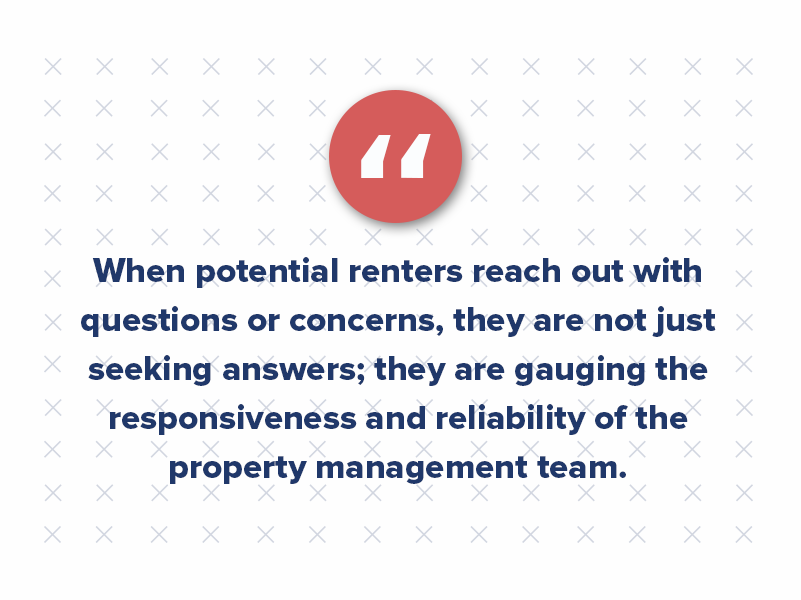
Efficient communication can often be the determining factor in a renter’s decision-making process. It bridges the gap between initial interest and final commitment, ensuring potential tenants feel valued and understood, ultimately making it more likely for them to choose your property over others.
17. Regular Market Analysis
Property managers and owners must be attuned to the pulse of the local rental market. With fluctuations in demand, economic shifts, and seasonal variations, rental prices can be highly dynamic. Staying updated on local market trends can help you gain insights into what competitors are charging, what amenities are in demand, and what potential renters prioritize in their housing search.
Proactively adjusting pricing in response to these multifamily trends doesn’t just ensure you remain competitive; it also demonstrates to potential residents that the property is in touch with the community’s needs and is adaptable. In a market where every edge counts, this level of responsiveness can be the difference between a fully occupied property and vacant units.
18. Enhance Green Spaces
An oasis of greenery in the form of well-maintained gardens, terraces, or even strategically placed indoor plants can significantly elevate the aesthetic and ambiance of a multifamily property. Beyond just their visual appeal, these green spaces and elements contribute to a sense of tranquility and well-being, offering residents a respite from the hustle and bustle of urban life.
The presence of plants can also improve air quality, acting as natural air purifiers. By investing in landscaping and indoor plants, properties not only enhance their visual appeal but also create a healthier and more rejuvenating environment. Such thoughtful touches signal a property’s commitment to providing residents with a holistic living experience, making it more enticing for potential renters seeking more than just four walls and a roof.
19. Invest in Upscale Amenities
Multifamily properties that offer more than just living spaces are capturing the attention of discerning renters. Common areas such as state-of-the-art gyms with the latest fitness technology, co-working spaces catering to the growing number of remote professionals, or entertainment zones with gaming areas and mini-theaters can truly set your property apart. These unique amenities serve as value-added propositions, providing residents with convenience, luxury, and diverse lifestyle options right at their doorstep.
These premium features offer a richer living experience, which warrants a justified increase in rent. When residents perceive tangible value in these amenities, they’re more likely to understand and accept a slightly higher rental cost. Ultimately, by elevating the standard of living through these specialized common areas, properties can significantly enhance their NOI while fostering a greater resident experience.
20. Continuous Staff Training
Investing in thorough staff training, especially in customer service excellence, is not just a box to tick; it’s a strategic move for the longevity and success of your multifamily property. Cutting corners in staff training can lead to missed opportunities, miscommunications, and unsatisfactory resident experiences, which can negatively impact your property’s reputation and occupancy rates.
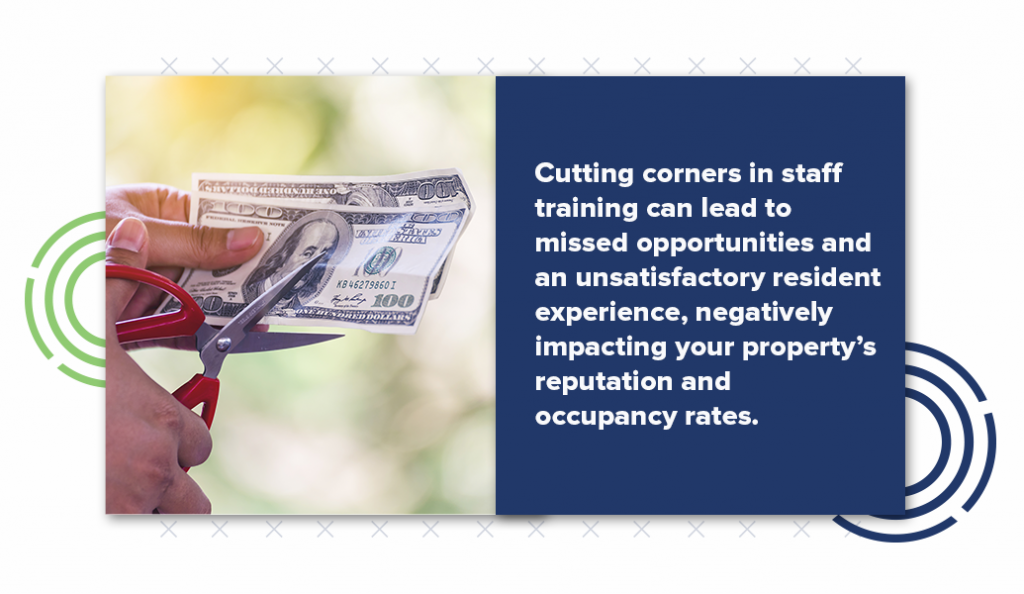
When residents see familiar faces in the management team and service personnel, it fosters a sense of community and trust. Familiarity can often translate to increased comfort and security, which is essential in a resident’s decision to renew their lease.
On the flip side, frequent staff turnover can incur additional costs in hiring and training, and it may disrupt the seamless operation and rapport built with residents. In essence, by prioritizing staff training and retention, properties ensure smooth operations and a positive environment and enhance their bottom line by minimizing unnecessary expenses and optimizing renter satisfaction.
Boosting Demand with Comprehensive Multifamily Branding
Increasing occupancy and NOI is a blend of strategic multifamily branding, robust property management marketing, and understanding tenant needs. With these tips and the expertise of a multifamily branding agency, property managers can navigate the challenges of the rental market, ensuring their properties remain in high demand. Remember, in real estate, multifamily branding isn’t just a name — it’s an experience.

Top Strategies for Effective Multifamily Lead Nurturing
Multifamily marketing professionals face unique issues with lead nurturing through the marketing funnel.
For the multifamily market, issues arise in the form of heavy competition from neighboring apartments and issues with customer retention. For developers, problems arise with a lack of awareness limiting incoming leads. For vendors, issues arise with qualifying incoming leads to ensure they are legitimate and within the proper target audience.

While many methods help generate leads, the best way to ensure continued success is to nurture your leads. Through lead nurturing, continued strategic contact can help ensure that the leads you generate are properly qualified and remain interested in your offerings.
While lead nurturing is critical to the continued marketing success of any multifamily business, most companies fall woefully behind. According to HubSpot, 65% of B2B marketers have not established lead nurturing. This is a huge missed opportunity as organizations that excel at lead nurturing generate 50% more multifamily leads at 33% lower cost.
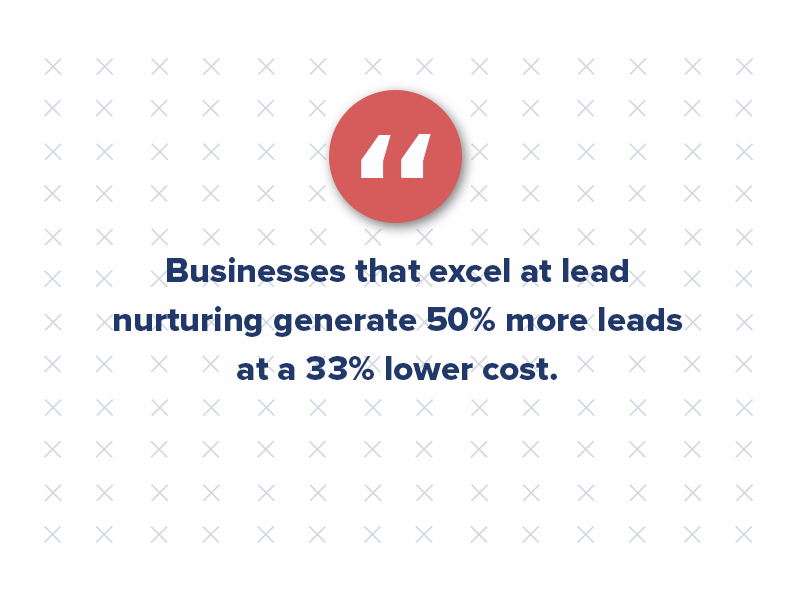
And Annuitus Group suggests that not only do companies who use automation to nurture their leads generate 451% more qualified leads but also that those leads are 47% more likely to make a larger purchase than their non-nurtured counterparts.
Knowing these numbers about lead nurturing, how many multifamily marketers miss it?
Valuing a Digital Multifamily Marketing Strategy
The commercial real estate industry is known for being behind the curve in adapting to the latest trends — especially technology. The same is true for marketing techniques.
Groups with no expertise in the industry have no idea how to use digital marketing to meet their marketing needs strategically. Partner this with a hesitancy to leave behind expensive “tried-and-true” outbound methods, and it becomes clear that commercial real estate marketers are unsure how to invest in digital multifamily marketing.
The key to robust digital marketing is to attribute value to that strategy. Many commercial real estate marketers fail to do so, hurting them in the long run.
The Advantages of Lead Nurturing
- Sustain Engagement: Keep your prospects engaged and maintain top-of-mind awareness for when they are ready to purchase.
- Guide Toward Sales: Nurture your contacts by seamlessly integrating sales messages within informative and valuable thought leadership content.
- Enhance Conversion Rates: Boost the likelihood of converting leads into sales by adopting a nurturing approach that adds value, ultimately maximizing the return on investment (ROI) for acquiring contact data.
- Prevent Lead Fatigue: Reduce the risk of overwhelming leads with aggressive sales pitches immediately after they download one of your resources. People generally prefer an educational and nurturing approach, which contributes to the success of building relationships and driving conversions.
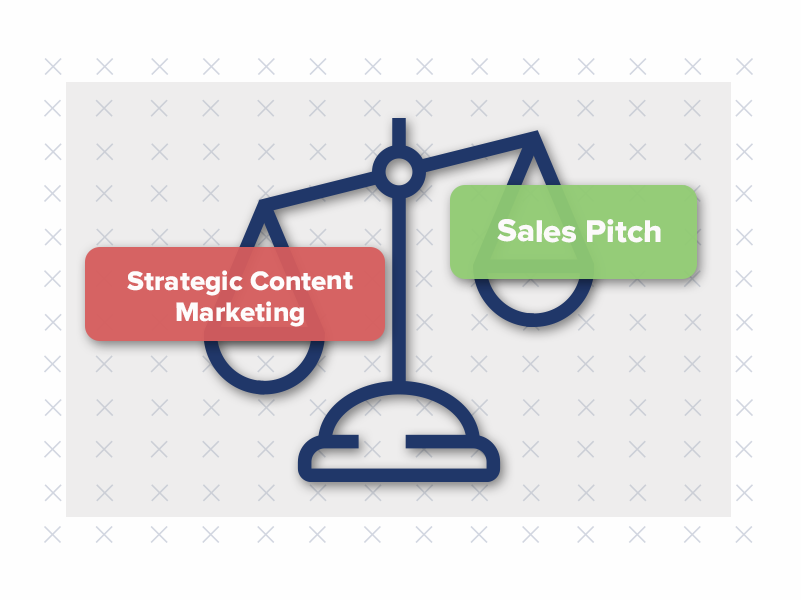
Finding a Balance
Digital marketing relies on the perfect balance of digital strategies, working together in an integrated manner to ensure consistent messaging and continued contact with an apartment lead or prospect. This means unique content — such as blogging, offers, social media content, email marketing, etc. — should all be tied around a central persona, strategy, and buyer’s journey.
Adding these aspects together and ensuring you have the team and resources to run it all adds up. However, compared to the average standard spend on outbound strategies, the cost is typically much less. In fact, inbound multifamily marketing costs 62% less than traditional marketing, yet each dollar spent on inbound marketing generates 3x as many apartment leads.
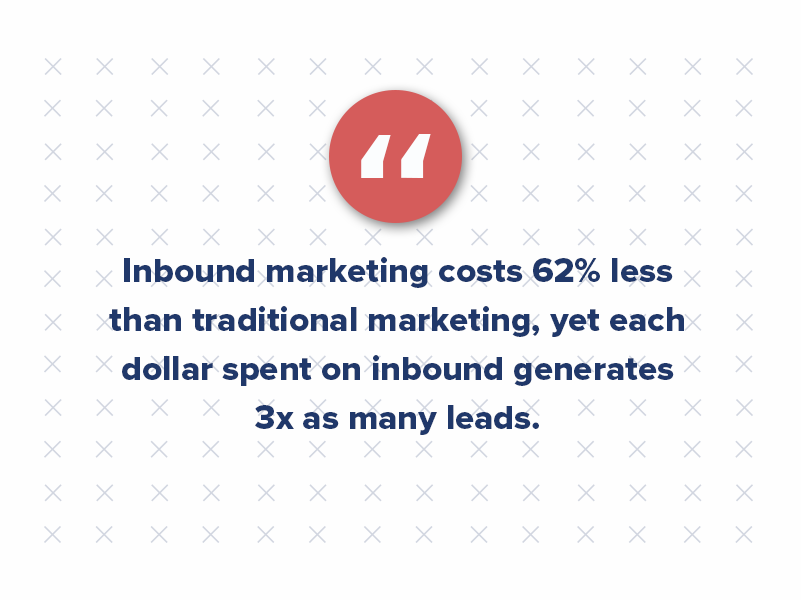
7 Types of Email Marketing Campaigns for Multifamily Lead Nurturing
Typically, when speaking of apartment lead nurturing, people instantly think of email drip campaigns. These are email campaigns automated to go out to a list over a specific period. While this can be a lead nurturing method, it is not the only method.
The fact of the matter is that many types of lead nurturing emails may be used depending on your needs. And each has a benefit or strength.
1. Welcome and Engagement Nurturing
When bringing new leads aboard, it’s wise to nurture them while they are still hot — actively interested. Capitalizing on the novelty of your introduction to them can be a great foot in the door to a positive impression. However, it’s also important not to scare away your multifamily leads by coming off as overeager. This is where a “welcome” campaign comes into place.
The benefit is two-fold: While engaging your lead with your brand, you can use this campaign to gather information to segment the lead further. Step one of a welcome campaign is always the same — you take the time to welcome your new multifamily lead and let them know what to expect. You can also offer a free resource.
Going an extra step, you can offer these leads a way to get customized information depending on their interests. This may take much work on your backend through list segmentation and automation software. But if the framework is there, it’s work that pays off. Offer a weekly newsletter on multifamily trends, interesting statistics, or relevant industry articles.
Engagement campaigns are similar and can often stem as an off-shoot of your welcome campaign. Want feedback on a certain aspect of your business? Engage a list focused on that aspect of a focus group or survey session, and motivate them to participate. In this form of nurturing, your imagination is the limit.
2. Qualification Campaigns
A qualification campaign allows you to hone in on a lead in a critical interest time. Let’s say a multifamily lead downloads a few offers in quick succession. Adding this lead to a qualification campaign lets you speak to them clearly as they try to discover the answer to their problem. Sending more related offers with opportunities to touch base with your team brings you closer to making the lead sales qualified.
3. Traditional Nurturing Campaigns
A traditional nurturing campaign takes your lead’s interest and continues to offer relevant educational material. These types of campaigns most often accompany your overall marketing strategy. This campaign includes keeping in touch with a multifamily lead, giving them small opportunities to convert.
4. Event Campaigns
Whether hosting an event online or in person, an event campaign can help pique interest and attendance. Even if you’re trying to boost attendance to your booth at an industry conference, event campaigns are a great way to spread awareness, boost interest (usually by a unique offer), offer reminders and other great tips leading to your event, and provide an excuse for strong feedback and thank you emails that can further promote conversion.
5. Promotional Campaigns
If you have some multifamily leads you feel are on the edge of closing, a promotional campaign might be a nudge in the right direction. A promotional campaign should be very controlled, not to cheapen the perceived value of your product. Discounts, free bonuses, or even referral bonuses are good ways to augment a promotional campaign.
6. Re-engagement Campaign
Do you have a lot of leads that have gone cold? Purging these leads from your lists can seem like a waste. Instead of letting these multifamily leads go, why not implement a re-engagement campaign? This includes reminding them of your value or offering them something special to engage.
7. Upsell Campaign
Don’t let the title concern you. While upsell campaigns have a negative connotation, they don’t always have to mean or reflect upselling. Rather, an upsell campaign promotes your offerings to existing customers. In some cases, this means offering additional services.
Return Is in the Eye of the Beholder
Knowing that multifamily lead nurturing is far more complex than most marketers realize, the question becomes, which form offers the best return? The answer is not so simple. While each of these nurture campaigns requires a certain amount of upfront investment, the payoff depends entirely on your business.
The question comes down to which problem you are facing the most. If your issue is moving leads down the pipeline, a qualification campaign will most benefit your needs. If you are working on reviving multifamily leads, engagement, and re-engagement campaigns should be your go-to.
Choosing a nurture campaign tied to your strategy is more important than taking a set-it-and-forget-it route. This is where you can make the most significant impact on your business. Only then will you see sustainable success in nurturing your multifamily leads.

What to Expect When Starting an Inbound Marketing Campaign
Today’s marketing has evolved from interruptive tactics to a customer-oriented approach called inbound marketing. This route empowers your customer to be equipped with all the information they may need to decide without feeling like they’re being “sold to” from the first interaction.
In commercial real estate, everything from a property management company to multifamily vendors serving the space needs a marketing tactic that relies on warm leads.
When evaluating whether an inbound marketing campaign is right for your multifamily business, there are a few things to understand first.
Time Is an Investment
The hardest thing for clients to wrap their heads around is the time it takes to get an inbound marketing campaign in full swing. While everyone is looking for instant gratification for their multifamily marketing ROI, we remind our clients that time is an investment. We set expectations early on that inbound marketing isn’t a quick fix, but rather a long-term solution.
Let’s say a multifamily property wants to create buzz during lease-up for three months. A full-funnel inbound approach may not be ideal for this short-term need. A social media marketing strategy may better fit this quick fix. However, if they want to maintain a marketing strategy that identifies prospective residents, targets content, and creates a steady lead nurturing system — inbound marketing may be the ticket.
Inbound marketing is built on steps that can’t be skipped or left out of your strategy. A ramp-up period for inbound may take the three months that the multifamily business above wanted for simply heavy promotional marketing.
Rather than short bursts of promotion, with inbound, you have to build a solid foundation first. If not, your entire inbound marketing campaign process will be working backward to fix the broken links.
However, when you give inbound the time it needs to get the working pieces in place, you start seeing your work pay off.
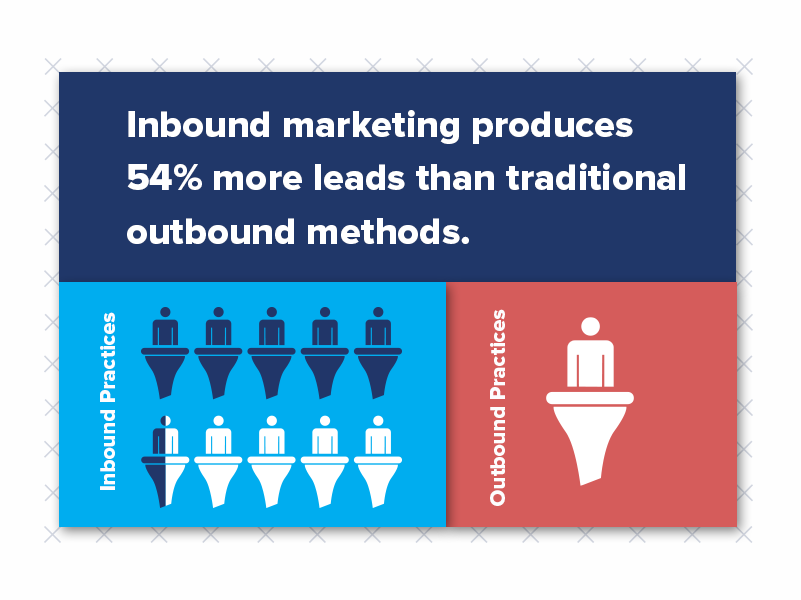
Consider the following stats from HubSpot, a leading marketing automation software company:
- 92% of companies using inbound marketing increased their traffic, and 40% increased their traffic by at least 75%.
- 85% of companies using inbound marketing increase traffic within 7 months
- Blogging champions as the #1 method for increasing traffic, with SEO in second place
- “Other” inbound marketing techniques (i.e., landing pages and calls-to-action) are ranked the #1 method for increasing leads
- 42.2% of companies using inbound marketing increase their lead-to-sale conversion rate
- 49.7% of companies using inbound marketing increase sales within 7 months
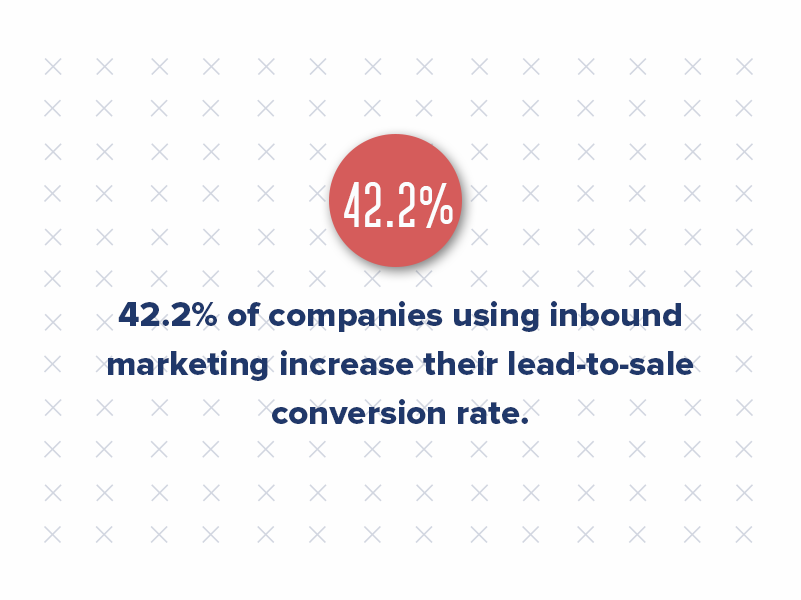
Results Come From Strategy
Like many things in life, you can expect to get out of an inbound marketing campaign what you put into it. When you’re looking to see the magic of inbound marketing in action, you can’t sit back and let it go on its own. It takes constant review, regular planning, and lead nurturing. This could be in the form of ready-to-rent leads showing interest in your property solely by viewing your content and social media.
By not taking shortcuts, you’ll be pleased with the results your campaign brings in. But what takes so much time?
Buyer Personas
The first step is always research. The cornerstone of any inbound marketing campaign is developing buyer personas. Buyer personas are semi-fictional characters representing your ideal resident or customer and going beyond just demographics. Your personas will help target all content and strategy surrounding the campaign. These can take a few months to develop, as it’s important to interview residents to get insight into your target audience.
Keyword Research
Much of the ramp-up period consists of research. Once you know your target, you need to know how you rank for industry-specific jargon your audience uses. For instance, if your business is a real estate investment company, maybe you rank high in search terms for “multifamily investing” or “real estate investment firm.” By using a keyword analysis tool like SEMRush, Ahrefs, or Moz, you can identify how you’re ranking for very specific keywords. You can then optimize the content you create to feature those keywords.
Multifamily Website Design
Before setting up a buyer’s journey for your target resident to navigate online, your website has to be optimized for user experience (UX). A poor website can halt the effectiveness of a well-planned inbound marketing campaign. For instance, if people can’t find the leasing page or have difficulty finding floorplans, they’ll likely lose interest. Do not make your audience hunt for what they are looking for.
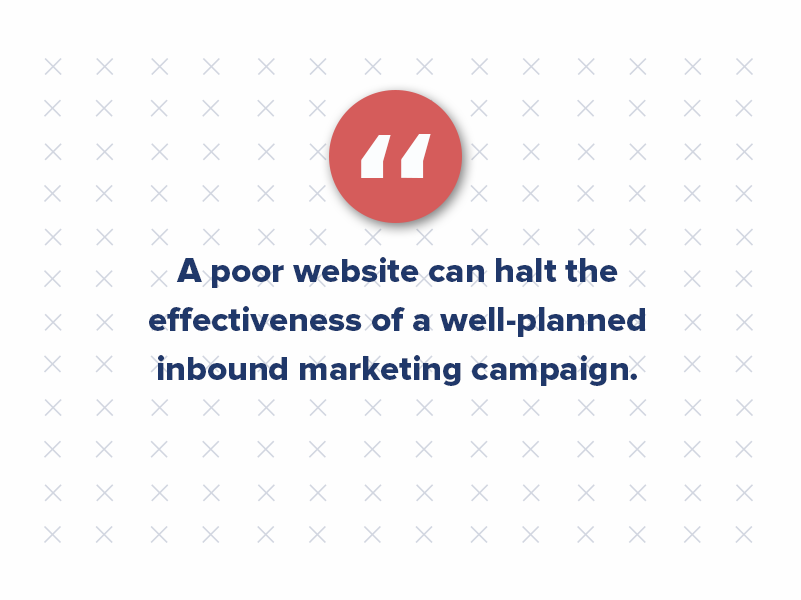
Content Mapping
You can plan the content once you’ve researched and optimized your website. You’ll want to create different content types for each stage in the buyer’s journey — awareness, consideration, and decision. Instead of publishing blogs on the fly or posting to social media randomly, plan out your content strategy. This will give your inbound marketing campaign direction, purpose, and organization.
HubSpot Set-Up
HubSpot is an amazingly effective tool for marketing automation. It helps build and automate workflows, email campaigns, social media scheduling, analytics, and more. Setting up your workflows, email templates, and building out social media accounts in HubSpot helps create a solid foundation.
Goals and Analytics
Without this step, there’s no way to assess the performance of the strategy you’ve put in place. Set SMART goals upfront — Specific, Measurable, Achievable, Relevant, and Time-based. Then, establish regular checkpoints to see how your strategy is doing. Tools like HubSpot, Google Analytics, and Klipfolio are great tools for measuring the success of your inbound marketing campaign.
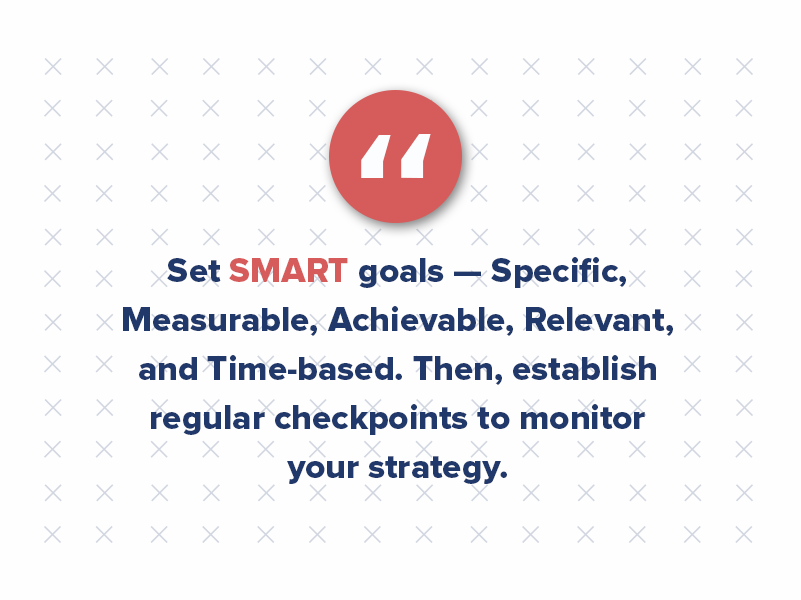
Now that you have the groundwork set, here comes the hard part — staying fully committed and on track with the goals you set. To be successful at inbound marketing, you must have faith. Those willing to let the process work through its entirety will see higher levels of success than those who change direction because they don’t see immediate results. Pausing your efforts or adding multiple layers to your pre-constructed plan will only lessen your impact. Be patient — we can’t stress this enough.
Become the Multifamily Marketing Expert
Inbound is a long, winding road of strategy, testing, retesting, and careful planning. While it may seem overwhelming at first, HubSpot supplies ample resources to teach new customers how to become inbound experts and more!
However, when it comes to being an expert and leader in inbound marketing for your industry, there are options. You can take it on yourself — which will likely be an overwhelming feat. You can hire an in-house inbound marketing expert, leaving the implementation and execution to them. If this isn’t your business’ specialty, you don’t have to go at it alone. You can also leave the heavy lifting to an inbound marketing agency.
As experts in inbound, an outsourced multifamily marketing agency (like Criterion.B) can put a business’ mind to ease by handling the entire process.
Taking Your Real Estate Leads From Multifamily Marketing to Sales
As inbound marketing begins to gain traction, more and more businesses are looking to adopt it into their strategy — either through a multifamily marketing agency or internally. Inbound promises to revolutionize multifamily marketing results for many of these businesses. But without deep research into the process, they find themselves frustrated at slow results or even lack of results.
For commercial real estate companies, in particular, doing inbound internally has quite the learning curve. With the business combining only certain inbound methods, they wonder why their methods are not working. And they may not even understand the need for a full inbound funnel.
However, when done properly, inbound marketing can be incredibly effective. Inbound can also be a great resource for an industry like real estate that’s stagnant in its marketing efforts.
The inbound funnel is undoubtedly the most important factor in inbound success. Every action in your marketing endeavors should point to a step in that funnel and how it relates to your buyer’s journey. But to understand how that funnel works, it’s essential to understand the role of lead qualification in the success of an inbound approach.
What Is Lead Qualification?
When working through an inbound funnel, the goal is to qualify leads. But what does it mean to qualify a lead?
Lead qualification involves gathering information about a prospect to determine where they fit in the buyer’s journey. This helps move a lead to a marketing qualified lead (MQL) and an MQL to a sales qualified lead (SQL).
The level a lead is at in the marketing funnel before reaching the customer is known as the lead’s lifecycle stage and are as follows:
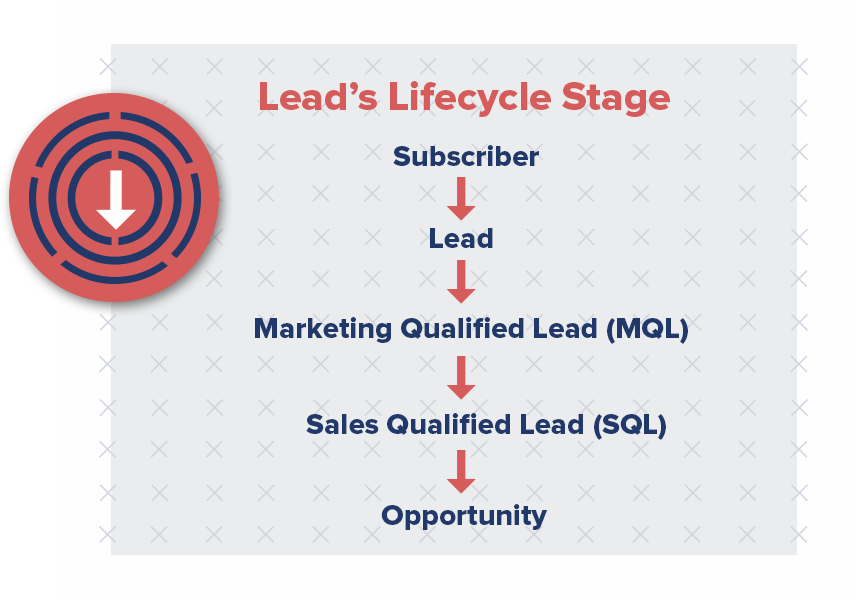
However, the definition of these lifecycle stages concerning your funnel varies depending on your business. For example, let’s say you worked at a property management company trying to attract residents to one of your properties. In that case, your lifecycle might be defined like this:
- Subscriber — A subscriber to your blog or newsletter but who has not engaged in downloading an offer or engaged for rental information.
- Lead — Someone who has downloaded a neighborhood guide or other entry-level information on your site but has not tried to engage about renting.
- Marketing Qualified Lead — Someone who has asked for information regarding rentals, be it availability or price range but has not engaged with a sale representative yet.
- Sales Qualified Lead — Someone who has asked for information on renting and fits/can afford the space; the person has also talked to a sales representative.
- Opportunity — Someone who has shown interest in renting and has engaged or seen the property.
For each company, the criteria may differ. If rents are a certain amount, or your complex is targeted toward seniors, a marketing qualified lead or SQL might need to match certain criteria before going forward. The next issue becomes — how do you get that information?
The Steps in Qualifying Your Real Estate Leads
Information is the end-all-be-all of multifamily marketing success. But gathering information is an increasing challenge. Digital concerns about privacy and security make the availability of information online difficult. Since information is needed to qualify leads for your sales team, it creates a need to be inventive in gathering information from leads. The best way? By creating an exchange.
The exchange of information for something else is key to the foundation of inbound marketing. Inbound marketers create offers that relate to each stage of the buyer’s journey. For example, they can offer an infographic on the neighborhoods in your city and make the offer downloadable in exchange for contact information.
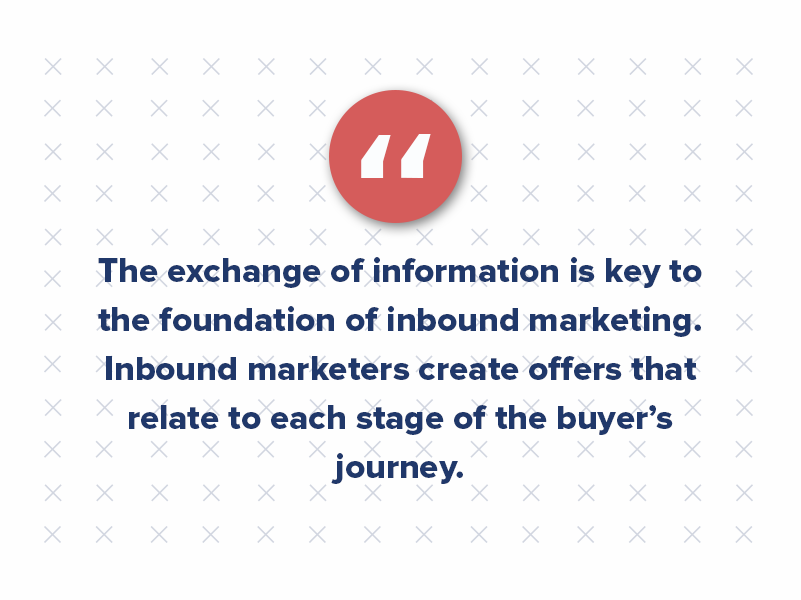
In this trade-off, consumers get valuable information, and their information is the price associated. The questions in the form of an offer, in turn, help the company qualify the lead. This helps expedite the sales cycle, rather than having sales pursue leads that are not ready to be contacted.
Again, determining the necessary information to qualify your real estate leads depends on your business, service, or product. If you’re a company offering residential services to multifamily residents, you may not want to ask revenue questions like you would when partnering with an apartment complex. Instead, you may want to know how often they need your service. It’s essential to ensure the information is relevant to the potential lead and that you’re asking the questions. For instance, not asking sales-focused questions when a lead is looking at an awareness offer.
This helps keep leads engaged while also gathering information for business needs. Knowing the answers to these questions not only qualifies your leads but gives you a better understanding of your potential customer.
Where Lead Qualification Goes Wrong
Now that you understand the importance of offers and forms, the next step is implementing this strategy. How do you accomplish this? It may seem like a straightforward process, but many intricacies are involved.
Asking for the Wrong Information
If you’re offering a prospect an awareness offer, then you’re not going to ask for detailed information about their background, job title, etc. That’s because the value of that information is held in higher regard to the prospect than the offer.
The lead’s lifecycle stage doesn’t match what you’re asking at the time. By the same token, you wouldn’t want to offer a demo of your resident management software to a property management company by only asking for name and email; otherwise, you might get a lot of parties not ready to buy or not within the scope of what your product supports. These issues can cause a loss of real estate leads or even an inaccurate funnel.
Failing to Follow-Up
Another issue companies face in lead qualification is failing to follow up on their real estate leads. Getting a lead that downloads your offer is great, but you can’t be sure of their intent without further engaging the lead. This can be anything from sending a series of nurture emails to following up with another offer or adding them to a curated newsletter. This nurturing lets you measure their continued engagement and gives you more opportunities to further qualify the lead with other content.
According to Invesp, 80% of new leads never convert into sales. With lead nurturing, however, companies can see up to 50% more sales-ready leads at a lower cost. Why? Because lead nurturing can be automated, it’s simple, and it helps to measure a lead’s readiness.
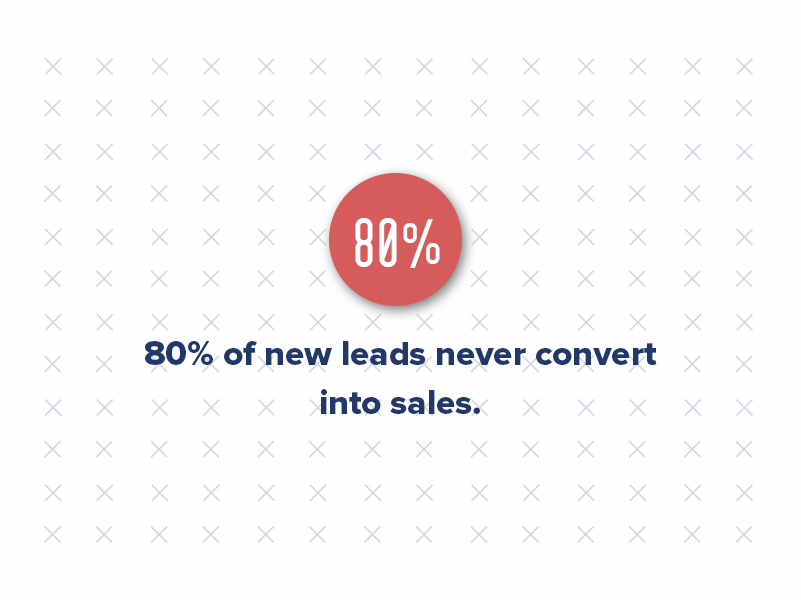
The most important thing about lead nurturing is to keep doing it. On average, it can take up to 8 marketing touches from a top-of-the-funnel lead to a closed-won customer. For many of your real estate leads, it may take even more. That means continuing with your nurture and follow-up with leads to ensure sales has a strong close.
Understanding Intent vs. Interest
Perhaps one of the biggest hangups in qualifying a lead is failing to understand a lead’s intent versus interest. A person in the neighborhood where you just built your swanky new apartment complex might have interest in your content because of location. But if they don’t fit the budget and aren’t looking to move, the intent is not there.
Marketers mistake interest for intent all the time, often leading to a marketing qualified lead being passed off as a SQL when that’s not the case. There are two options to help in this predicament, though — lead scoring and decision-based offers.
Marketing Automation Software
If you have access or interest, a marketing automation software like HubSpot offers lead scoring as a means to qualify your real estate leads. Lead scoring involves tracking any lead in your CRM across your site. With lead scoring, you can ascribe value to different blogs or page views, offers or email interactions. When a lead reaches a certain score, decided on by your team, they become sales qualified.
Decision Stage Offers
The secondary option is to use decision stage offers as a means of qualifying leads. This can be anything from making an appointment to see a space to offering a demo of a software. Creating a broader base of options for these offers can help you determine which leads are ready to buy. Leads who fail to engage with a decision offer when you have an array to choose from are likely not there yet.
Passing the Baton to Sales Qualification
So, your real estate leads are ready for sales — now what? Just because a lead is sales qualified, does not mean they are a good fit. Sales qualification is what makes a lead an opportunity and closes out the inbound funnel; it falls in the hands of the sales team to do this qualification. The reason? Just because a lead has interest and intent, doesn’t mean they meet the criteria of your product.
While lead qualification can help weed out those who don’t fit, it takes the sales team to assess fit, often using BANT (Budget, Authority, Needs, Timeline). What BANT does is ensure that the lead has the money, authority, and ability to use your product. Leads with poor BANT scores aren’t necessarily a waste of time, they may not be ready yet. But if that’s the case, it’s better for them to return to the cycle rather than have sales try to close a deal.
As a marketer, you’ll likely never know off the bat if a lead meets sales’ needs. That requires sales engaging with the lead first. Instead, it’s imperative to use lead qualification methods to ensure your real estate leads are qualified from a marketing perspective and ease sales’ jobs on the rest.




